VIETNAM JOURNAL © 2018 Callyn Yorke
Previous (2017) Vietnam Report
June 7 - August 16, 2018 ANNOTATED (2018) BIRD LIST
Van Long Nature Reserve Ninh Binh Province Northern Vietnam 12 July 2018
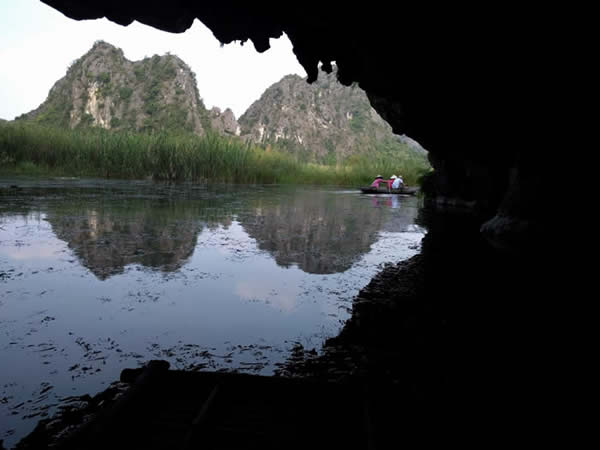
© 2018 Callyn Yorke
Contents
The Author taking a break on Lang Biang Mountain, Vietnam 15 June 2018
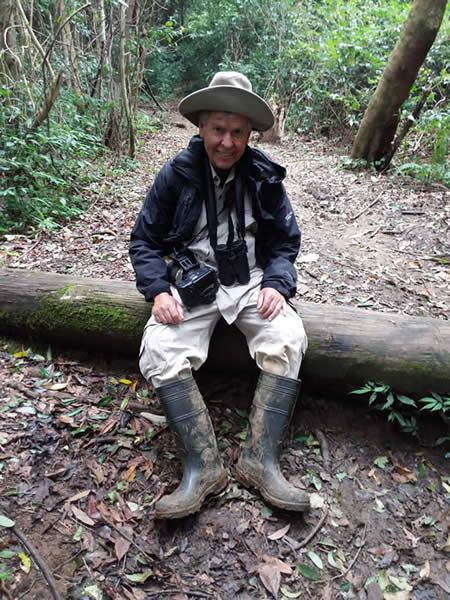
© 2018 Da Thao Nguyen Le
Ancient wisdom has it that a journey of a thousand miles begins with a single step. But after a steep climb and multiple missteps on the windward side of Lang Biang Mountain, the image of a ambitious, barefooted monk on a mountain trail, morphed into tentative thoughts like, "Sure, I can do this. Someone in their 80's almost made it to Everest base camp."
Between the drops of rain obscuring my vision and moisture from my breath condensing on the camera viewfinder, the five-hour, round-trip hike to the summit of Lang Biang was a work-out. The prize: Seeing some of the rare endemic birds of Vietnam, like a Collared Laughing-thrush (Trochalopteron yersini). But as the weather conditions deteriorated the likelihood of encountering one of these beauties seemed to be lessening with each belabored step.
Da Thao Le Nguyen on the trail to Lang Biang summit 15 June 2018

© 2018 Callyn Yorke
The cloud forest had, for the past hour or so, been eerily silent as we climbed a series of boxed stairs on the steeper sections, elsewhere stones, leaf litter and mud. Then, at about 200-meters below the summit, I caught a glimpse of a robin-sized, handsomely marked bird, silently hopping across the trail. A mosaic flash of gray, black, orange and yellow-green, its brief, curious stare, and the bird was gone in the wet undergrowth. I fumbled with my camera. There was no doubt as to its identity... Trochalopteron yersini... Incredible! A lifer for me, yet regrettably, one without even a blurry photo. Damn it!
The slog up and down Lang Biang wasn't all in vain, however. I had some luck photographing another Vietnamese endemic, Black-capped Fulvetta (Schoeniparus klossi), busily probing into the foliage of a moss and fern-covered tree near the junction of the trail and main road. Ten minutes later we caught a jeep ride back down to the park entrance.
Black-capped Fulvetta (Schoeniparus klossi) Lang Biang Mt. Vietnam 15 June 2018
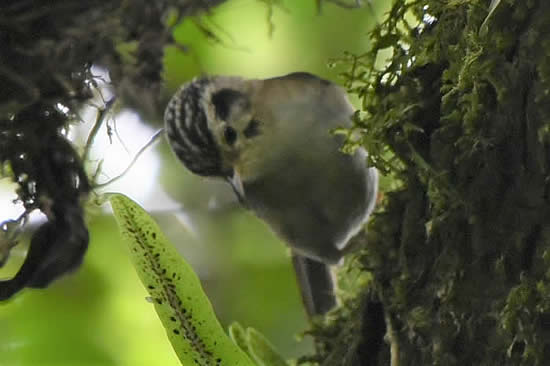
© 2018 Callyn Yorke
There are twelve recognized bird species entirely confined (endemic) to Vietnam. No other country in Southeast Asia (excluding Indonesia) has more endemic birds than Vietnam. Ornithologists believe there may be several more unique Vietnamese subspecies awaiting reclassification as full species. At least six of the currently recognized endemic bird species can be found in the DaLat Plateau, i.e., the Lang Biang - Di Linh region. Not surprisingly, visiting birders place DaLat high on their priority list.
Yet, without prior knowledge and guidance from experienced birders, finding those birds is problematic. Most of the roads are unlabeled, rendering maps largely useless. Da Thao Le Nguyen, a sharp-eyed birder, has resided in DaLat her entire life and is familiar with the locations where those endemics can be found. She is an indespensible source of expertise for visiting birders.
Da Thao had turned and was facing downhill on the steep staircase while adjusting her tote bag. She did not see the laughing-thrush I was whispering about and pointing at. But there could be another view of it up the trail, we thought, as we quietly ascended the stairs. No luck. My fleeting but clear view of the single collared laughing-thrush would have to be the highlight of the trek. We paused again to catch our breath, unsure of how much further we needed to go to see anything else noteworthy. Our only remaining obligation was simply reaching the windswept, foggy summit.
The Summit of Lang Biang Mountain overlooking DaLat, South Vietnam Elevation 2,167 meters 15 June 2018 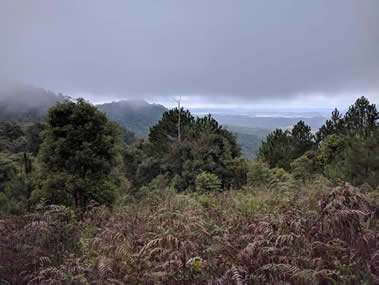
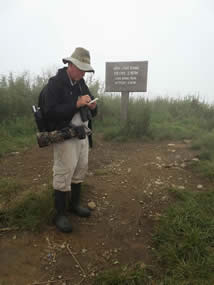
© 2018 Callyn Yorke © 2018 Da Thao Le Nguyen
Our Lang Biang birding adventure would be one of the first in a series of explorations of some of the more remote, mountainous regions of Vietnam, e.g. Fansipan (the highest peak on the Indochinese peninsula) and Bach Ma (possibly the rainiest place in Indochina). Over the next two months and by the time we returned to DaThao's hometown of DaLat in August, we would log over 3,000 kilometers by plane, bus, boat, train, taxi, and motorbike, into the most splendid natural preserves and iconic scenery of Southeast Asia. I recorded details throughout our journey using the old-fashioned, low-tech tradition of pen and pocket-notebook, here summarized chronologically and highlighted with photos. My camera gear included a Nikon D850 with multiple lenses; a Nikon 200-500mm was by far the most useful.
Duong Dong Harbor, Phu Quoc Island, Southwestern Vietnam 8 June 2018
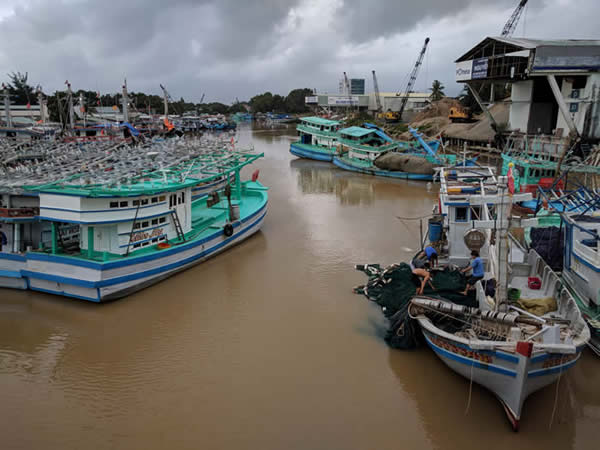
© 2018 Callyn Yorke
Phu Quoc Island (6/7-12) Once part of Cambodia (and still a bone of contention between the two countries), this large island in the southwestern corner of Vietnam (Gulf of Thailand) has one of the largest remaining stands of lowland rainforest in Vietnam. Naturally, we planned to spend most of our time there exploring for birds and other wildlife. But what we hadn't counted on was persistent rain and winds from a recently arrived typhoon. We were lucky to have as much as an hour a day without rain during our one-week visit.
The highway to Thom Bai through the national park on Phu Quoc Island 11 June 2018
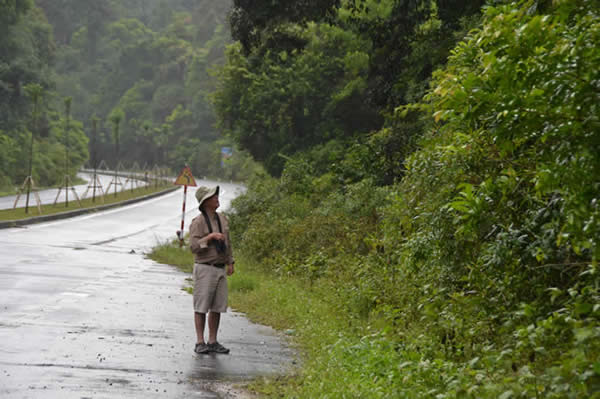
© 2018 Da Thao Le Nguyen
Phu Quoc Island National Park , VN 11 June 2018

© 2018 Callyn Yorke
Nevertheless, dodging periodic squalls, we managed to make short morning walks around the Shells Resort (east-central region) and a longer trip by taxi through the national park. Most of the habitat was severely disturbed near the beach; patchy second-growth offering the only cover for birds and wildlife. Access to the forested national park was only along the main highway where we stopped a few times for roadside birding. Interior roads and trails were posted and/or blocked, presumably for security reasons. I found very little online information about the birds of Phu Quoc Island. Evidently, the island is seldom visited by ornithologists or professional bird tour groups.
Bai Thom, Phu Quoc Island, VN viewing north into Cambodia 11 June 2018
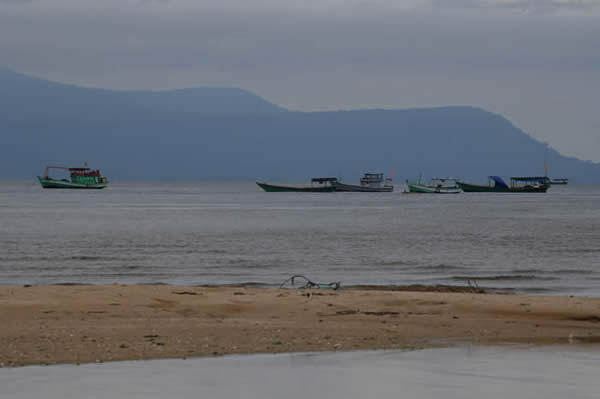
© 2018 Callyn Yorke
Yet, new bird species were added to our trip-list almost every day. A few of those species, e.g. White-bellied Sea Eagle, Brahaminy Kite, Red-wattled Lapwing, Brown-throated Sunbird, Purple-throated Sunbird and Yellow-vented Bulbul were not encountered anywhere else in our travels through Vietnam this summer. If the weather on Phu Quoc had been better during our visit, I am sure we would have had a much larger bird list than the one we ended up with (see Annotated Bird List).
Purple-throated Sunbird (Leptocoma sperata) Phu Quoc Island 12 June 2018
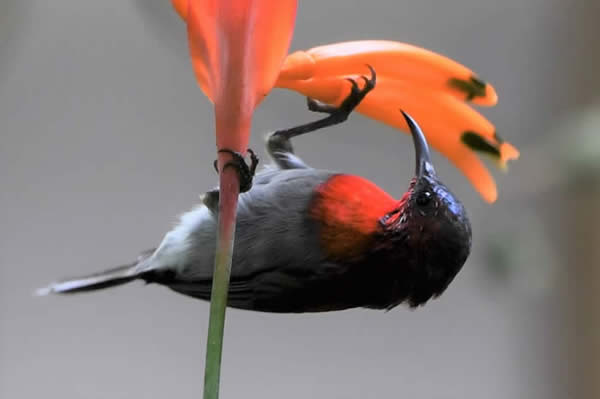
© 2018 Callyn Yorke
Phu Quoc Island, VN 12 June 2018

© 2018 Callyn Yorke
DaLat & Di Linh Highlands (6/13- 7/5)
Ta Nung Valley, DaLat Vietnam 16 June 2018
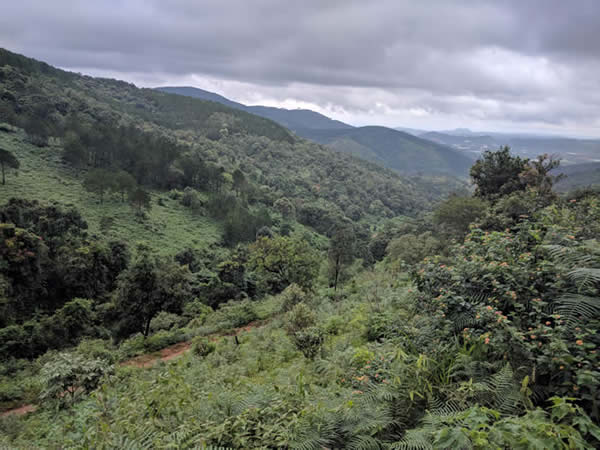
© 2018 Callyn Yorke
DaLat, at an elevation of around 1,500 m, has summers that are typically wet and wild. Scarcely a day passed without precipitation. Some forest birds were active all day, though peak activity was usually between 0600-1000 hrs.. The exception was almost anytime between rain squalls. Then, mixed species flocks of birds, e.g. Annam Barbet, Blue-winged Minla, White-throated Fantail, Bar-winged Flycatcher-shrike, White-tailed Leaf-warbler, Streaked Spiderhunter, Rufous-backed Sibia and Gray-crowned Crocias, among others, move frantically through the subcanopy and middle levels of the broad-leaved evergreen forest. A birder has to be quick as a gunslinger under fire to accurately identify and/ or photograph individual species within these evanescent flocks. Here it pays to have done some homework. Learning bird vocalizations is essential for birding in the rainforest. Many bird species are initially heard and anticipated, e.g. Streaked Spiderhunter; some may frequently be heard yet seldom seen, e.g. Annam Partridge.
White-throated Fantail (Rhipidura albicollis) ) often in mixed species flocks, DaLat 20 June 2018
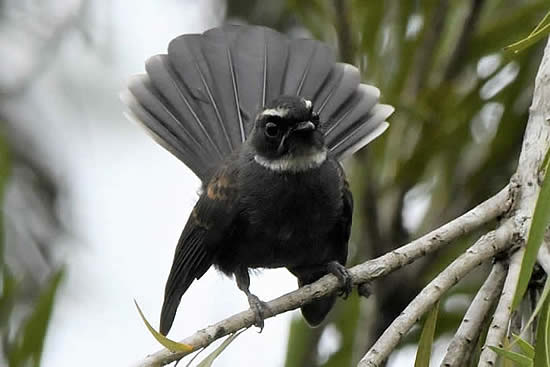
© 2018 Callyn Yorke
The Vietnamese Endemic, Gray-crowned Crocias (Crocias langbianis) Tuyen Lam Lake 1 August 2018
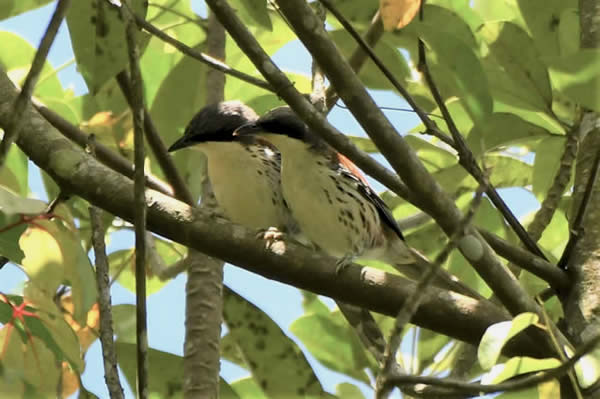
© 2018 Callyn Yorke
Among our favorite birding spots in the DaLat area were remnants of broad-leaved evergreen forest in the hills surrounding Tuyen Lam Lake and Ta Nung Valley. These rainforests are habitat islands in a sea of pine plantations and often brimming with birdlife. Unmarked roads and trails through the area offered many exiting possibilities for exploration.
But even the best spots were hit and miss on a day-to-day basis. It was difficult to predict where the birding would be best, particularly when raining. Sometimes just wandering along on a forest trail or roadcut through tall weeds with scattered trees would produce an astonishing variety of bulbuls. Frequently seen species included Black Bulbul, Flavescent Bulbul, Sooty-headed Bulbul, Mountain Bulbul, Puff-throated Bulbul and Black-crested Bulbul. The following day at the same location during the rains, perhaps only two of the above-mentioned species would be found.
Black Bulbul (Hypsipetes leucocephalus) Ta Nung Valley 16 June 2018
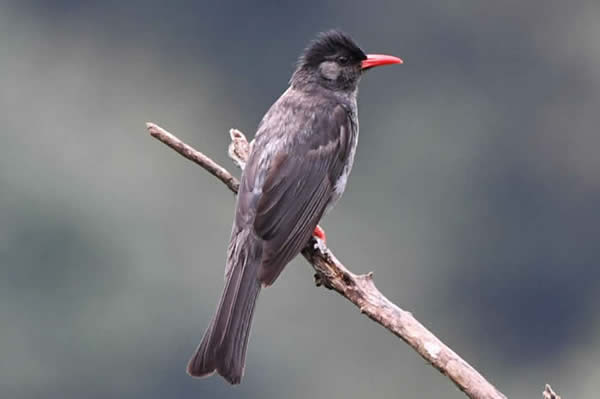
© 2018 Callyn Yorke
Seasonality is another important factor to consider when planning a birding trip to Vietnam. Summer is not particularly good for finding laughing-thrushes. Occasionally their brief but loud vocalizations were heard in the forest but the birds tended to remain concealed in the jungle. The notable exception was White-cheeked Laughing-thrush, which is seemingly a "backyard bird" in DaLat. Garrulous flocks of twenty or more were commonly found in all kinds of habitats, ranging from gardens on the DaLat University campus to broad-leaved hill forest and pine plantations.
White-cheeked Laughing-thrush (Garrulax vassali) Tuyen Lam Lake 22 June 2018
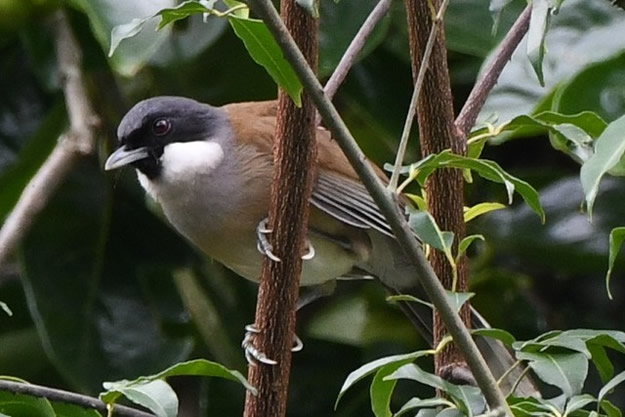
© 2018 Callyn Yorke
Part of the explanation for the difficulty in finding laughing-thrushes, e.g. the much sought after endemics, Collared Laughing-thrush and Orange-breasted Laughing-thrush, may be the prevalance of trapping. I was shocked to see so many cages in DaLat, Hanoi and Sa Pa, containing a large variety of forest birds, including several species of laughing-thrush. Some of those species I had never seen in the wild, such as the strikingly beautiful, Red-tailed Laughing-thrush. On two occasions, once in the Tuyen Lam Lake area and once in the mountains outside of Sa Pa, bird trappers were observed plying their trade.
Several species (see list below) of locally captured and caged birds for sale in DaLat 23 June 2018
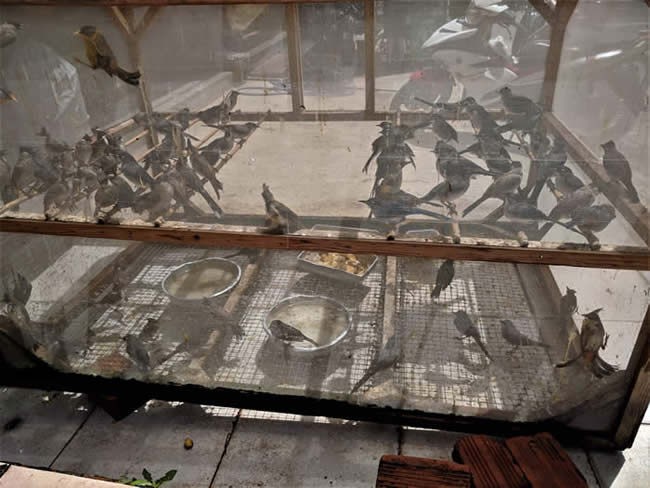
© 2018 Callyn Yorke
According to a recent You-Tube video I watched online while in Vietnam, bird trappers use a combination of techniques to lure birds to stick perches covered with glue. "Bird Glue" is specifically manufactured in China for this purpose. Caged "Judahs" birds are very effective, as is the use of recorded playback of the target bird's vocalizations. Birds are often handled roughly when removed from the glue traps; many caged birds I saw had injured legs and tracts of missing feathers. Quite disheartening was the sight of wild birds crowded inside small cages for sale in stores. The results of this popular livelihood have had ecological reprecussions. From what I could determine from field surveys, popular caged birds in Vietnam, e.g. Black-throated Laughing-thrush, are becoming increasingly difficult to find in their natural habitats; some species may have already been extirpated from the forests surrounding major cities.
The following is a list of caged birds I found for sale in a DaLat store (see above photo), ranked from most to least numerous:
1) Black-headed Sibia (Heterophasia melanoleuca) > 20
2) Red-whiskered Bulbul (Pycnonotus jocosus) 10
3) Sooty-headed Bulbul (Pycnonotus aurigaster) 5
4) Silver-eared Mesia (Leiothrix argentauris) 3
5) Rufous-backed Sibia (Heterophasia annectans) 2
Long-time residents admit that the nearly mile-high city of DaLat, glorified as the City of Eternal Spring, actually has two seasons: (1) Wet and (2) Very Wet. I'm not sure which one of those seasons we were experiencing. There were days we simply had to stay in our upper-level apartment overlooking DaLat University and keep and eye out for new birds flying by. I got more use from my umbrella during one week in DaLat than in ten years of living in Southern California. We often needed a back-up plan in rainy weather. Occasionally, when skies were threatening, Da Thao and I grabbed our umbrellas and visited some of the popular DaLat attractions, including the Crazy House, Dalat Palace Hotel and the Night Market.
DaLat Crazy House 3 July 2018 DaLat Palace Hotel 3 July 2018
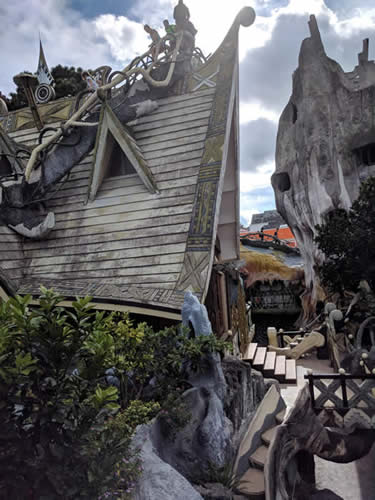
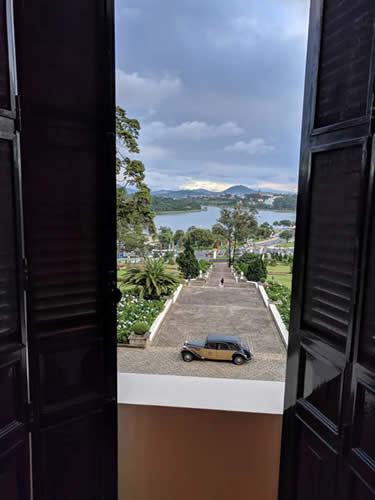
© 2018 Callyn Yorke
DaLat Night Market 2 July 2018
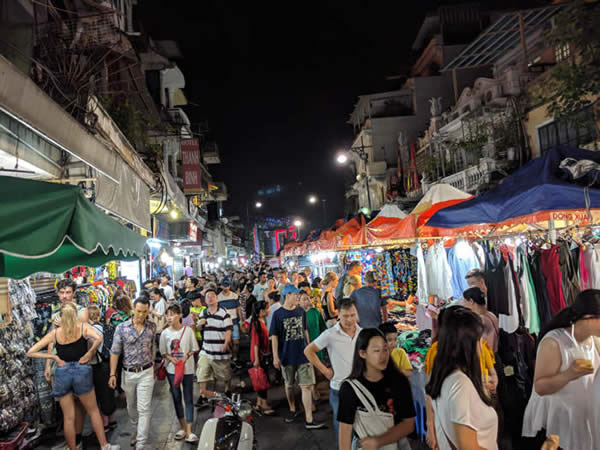
© 2018 Callyn Yorke
DaLat traffic outside our apartment 23 June 2018

© 2018 Callyn Yorke
Juliet's Villa, Di Linh 28 June 2018

© 2018 Callyn Yorke
We spent seven days in the Di Linh highlands, commuting by motorbike between Juliet's Villa and the luxuriant hill forest of Suoi Lahn. Although the latter is well known to bird tour operators, Juliet's had a surprisingly good representation of open-country birds. Combining both casual observations at Juliet's with regular morning trips to Suoi Lanh, we concluded our visit with a Di Linh bird list of fifty identifiable species, a few of which were not found elsewhere in our travels, e.g. Long-tailed Broadbill, Black-headed Parrotbill, and Red-billed Scimitar Babbler.
Red-billed Scimitar Babbler (Pomatorhinus ochraceiceps) Suoi Lanh 25 June 2018

© 2018 Callyn Yorke
Almost every morning about an hour before daybreak, the cheery, flute-like song of a Blue Whistling Thrush wafted in through the bungalow window. No need for an alarm clock. Other species were also regulars at Juliet's, including a pair of Common Iora nesting near the dining area. Scarlet-backed Flowerpecker and Plaintive Cuckoo usually made brief appearances each morning. Lone trees in the surrounding coffee plantation produced the only Lineated and Blue-eared Barbets we found in the region. Other unique sightings around Juliet's included a vocal Peaceful Dove and an evening fly-by of a Large-tailed Nightjar. Each day at Juliet's produced new birds for our trip list.
Blue Whistling Thrush (Myophonus caeruleus) Juliet's Di Linh 24 June 2018

© 2018 Callyn Yorke
Lineated Barbet (Psilopogon lineatus) Juliet's Di Linh 24 June 2018
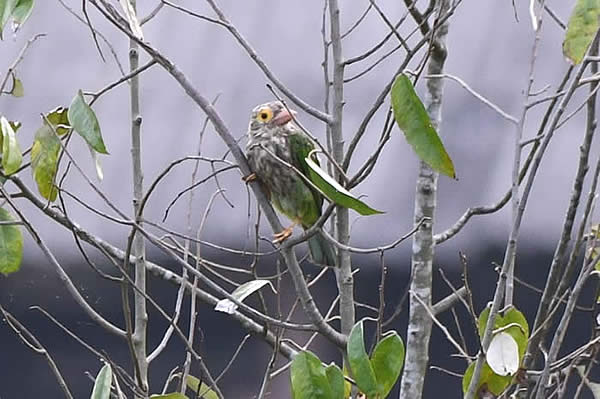
© 2018 Callyn Yorke
Birding the renowned hill forest of Suoi Lahn had been our prime objective. Initially, I hired a taxi for about three hours of birding by walking along the main road through the forest. As usual, long periods without seeing much were punctuated by the sudden appearance of a vocal mixed species flock frantically searching foliage for insects, seeds and fruit at all height levels. Within minutes the itinerant flocks had moved on. We did as well. Three hours of birding seemed to pass quickly and was scarcely enough time to appreciate the surprising avian diversity of the Suoi Lahn forest.
Summit roadside, Suoi Lahn 25 June 2018
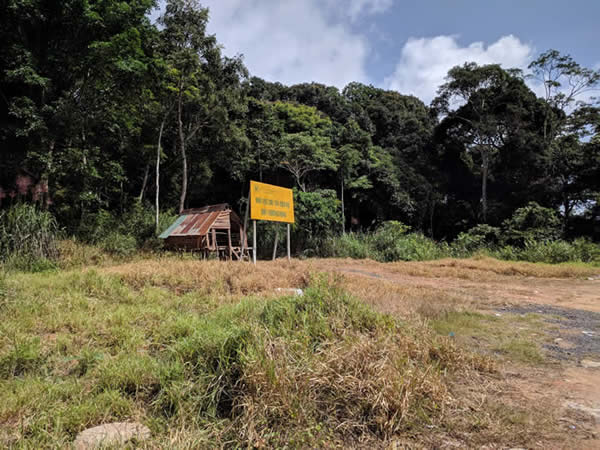
© 2018 Callyn Yorke
We were eager to return early each morning to have another crack at the birds of Suoi Lanh. Fortunately, precipitation was relatively light and intermittent during our morning visits; most of the rain fell late in the afternoon and evenings. We found hiring a motorbike for the week (about $7 per day) more convenient and cost-effective than using a taxi. Traveling by motorbike between Juliet's and Suoi Lahn took about 20-minutes and allowed an unobstructed view of the surroundings, which sometimes featured new birds for our trip list, e.g. Indian Roller and Large-billed Crow.
Indian Roller (Coracias benghalensis) road to Suoi Lanh, Di Linh 30 June 2018
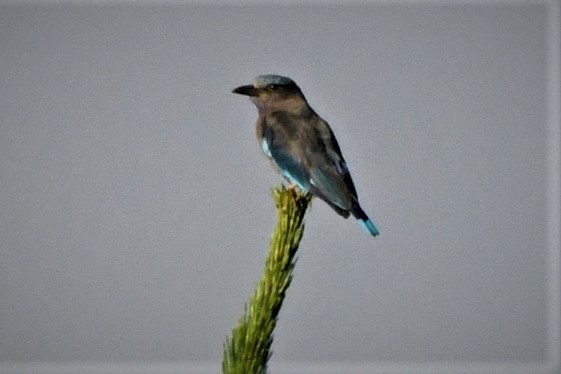
© 2018 Callyn Yorke
Waterfall at Juliet's Villa, Di Linh 26 June 2018
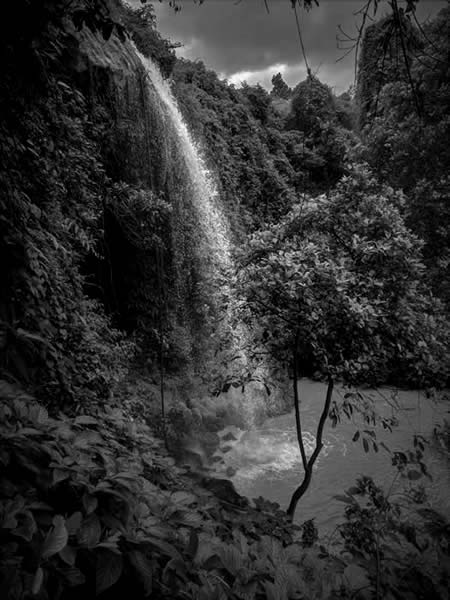
© 2018 Callyn Yorke
Rice paddy fields adjacent to Juliet's Villa, Di Linh 26 June 2018
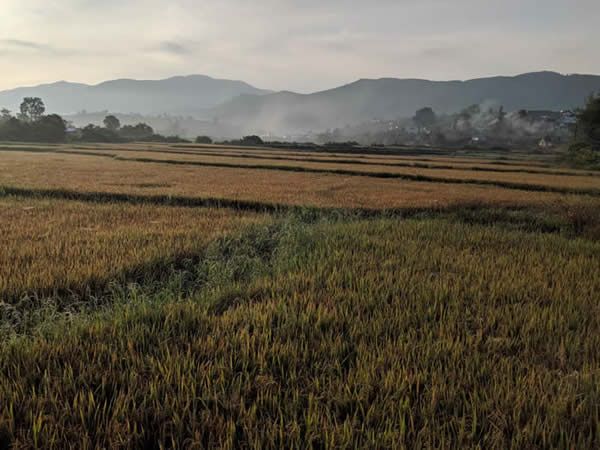
© 2018 Callyn Yorke
Lotus pond, Hanoi University
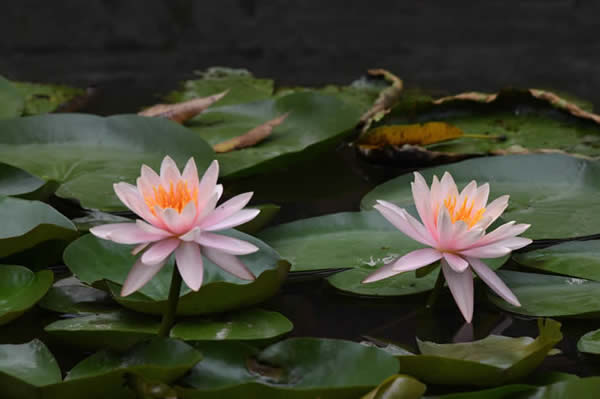
© 2018 Callyn Yorke
A bewildering array of accomodations was available in Hanoi; we ended up at a mid-priced hotel in the Old Quarter. There, we found tons of other travellers, nearby big attractions, the finest restaurants and best bargain-shopping Hanoi had to offer. Needless to say, there was never a dull moment during our visit to Hanoi. No one visiting Vietnam should miss an opportunity to spend a few days in this fascinating old city.
Da Thao had visited the Ho Chi Minh Mausoleum as a little girl but had only a vague memory of it. So, this impressive historical landmark was high on our city tour agenda. There was only one small problem. We learned from the hotel staff the day before that the interior of the mausoleum was closed for rennovation. Oh well.
Life in Hanoi July 2018
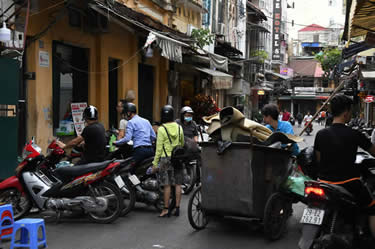
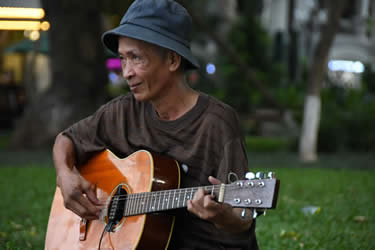
© 2018 Callyn Yorke

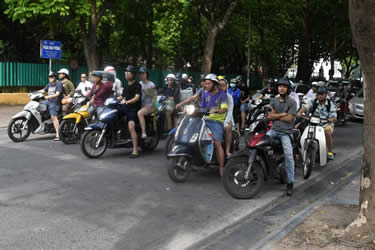
© 2018 Callyn Yorke
We ended up having a very enjoyable morning touring the mausoleum grounds, including a full-scale replica of Uncle Ho's home and garden. The latter was alive with birds. Of course, neither of us had thought it polite to bring binoculars. At least one species we saw fly over, a hawk (Accipiter sp.), went unidentified.
The Ho Chi Minh Mausoleum, Hanoi 7 July 2018
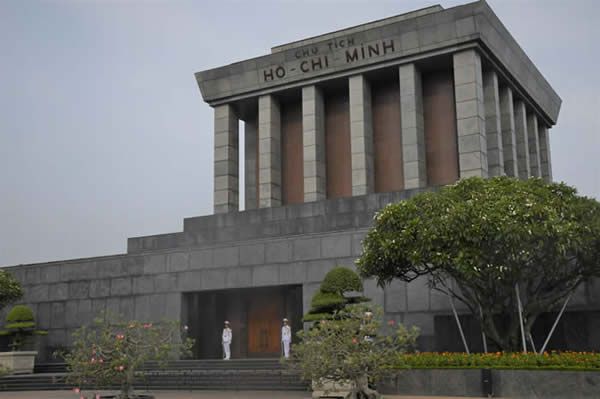
© 2018 Callyn Yorke
The grounds of the adjacent presidential palace included a separate botanical garden open to the public. The following morning, Da Thao and I spent a couple of hours walking around beneath some beautiful old trees (each numbered but mostly unlabeled) forming a nearly closed canopy forest. The shady paths through the park were welcomed relief from the rapidly building summer heat and humidity. Birdlife there, although vocal and conspicuous, was limited to a handful of cage-escapees, such as Magpie Robin and Red-whiskered Bulbul.
Magpie Robin (Copsychus saularis) Outside the Hanoi Botanical Garden 7 July 2018
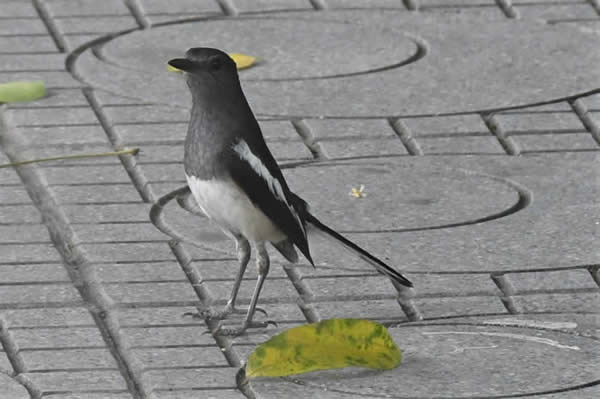
© 2018 Callyn Yorke
The Hanoi Women's Museum received good reviews in travel guide books. It was a relatively short taxi ride from the Mausoleum and well worth the visit. Inside there were three floors of exhibits featuring costumes, handicrafts, images and descriptions of the roles of Vietnamese women, historically and in contemporary society. Most memorable for me were the many fine black-and-white photos of Vietnamese hill tribes made by Nguyen Hong Nga, a talented young Vietnamese photographer.
Nguyen Hong Nga exhibit, Vietnamese Women's Museum, Hanoi 7 July 2018
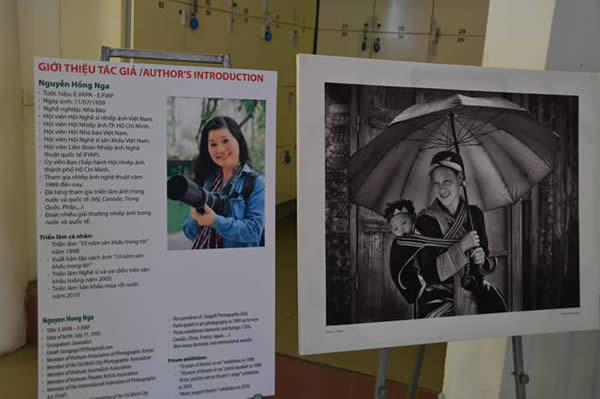
© 2018 Callyn Yorke
Another must-see Hanoi attraction (for me, though not so much for Da Thao) was the Hoa Lo Prison, built by the French to isolate political troublemakers in the colonial period. During the American War, captured airmen and others were imprisoned there, some for many years. Among the more famous American POW's was the late Senator John McCain (1936-2018), who was shot down in October 1967 while bombing Hanoi during Operation Rolling Thunder. He was captured by the North Vietnamese and held at Hoa Lo Prison until a negotiated release of all POW's in 1973.
A poster display, with many photographs and personal letters written by American POW's, was an unforgettable segment of the Hoa Lo museum exhibits. Though not as grimly comprehensive and gut-wrenching as exhibits in the War Remnants Museum in Saigon, I found it difficult to pull myself together after walking through the darkened rooms, staring into mysterious, shallow cubbys, and long, narrow hallways echoing the nickname, "Hanoi Hilton."
Interior room of the Hoa Lo prison museum 7 July 2018
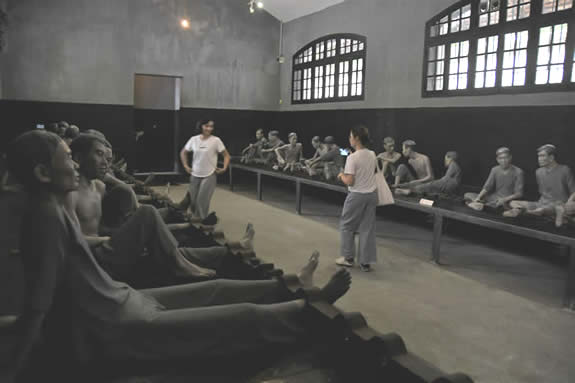
© 2018 Callyn Yorke
Hao Lo museum exhibits were thoughtful, poignant and fairly presented in my view. Photos of the bombing devastation and civilian casualties in Hanoi were, predictably,very emotive. Individual stories of imprisoned airmen, their heartfelt letters and memorabilia, served as testimonials to a seemingly hopeless plight as American POW's. Evidently, no American ever escaped from Hoa Lo; rescue must have seemed a vanishingly remote possibility as days melted into months, then years.
The heavy humidity and midday heat stewed in the old fortress, creating an inescapable atmosphere of brutal reality. Hoa Lo, even if left entirely vacant, would almost be enough by itself in dim light and haunting silence.The inclusion of informative posters, graphic photos and manikin prisoners, effectively distracts the visitor from the atrocities and horrors that must have been a daily occurrence within the walls.
Da Thao was visibly exhausted after only about a half hour of our visit. She chose to sit on a bench, fanning herself, and wait for me to finish studying a fascinating series of American POW exhibits. Finally, at an end point when the viewer had seen about all the grim examples of destruction and suffering that could possibly be assimilated in a single visit, there was a small grouping of photos showing something unexpectedly refreshing. This easily overlooked part of the exhibit was appropriately entitled, Bridge for Peace.
Unbelievably, there were recent photos showing the return of Senator McCain to Hanoi, being embraced by one of the North Vietnamese soldiers who had saved him from drowning in a nearby lake where he had parachuted after his plane had been shot down. There were big smiling faces in the photos --mutual gratitude reaching back through decades of unresolved misunderstanding and suffering. This was unquestionably one of the finest hours for Senator McCain, Vietnam, America, and all of humanity.
Hoa Lo prison museum exhibit of the John McCain story 7 July 2018
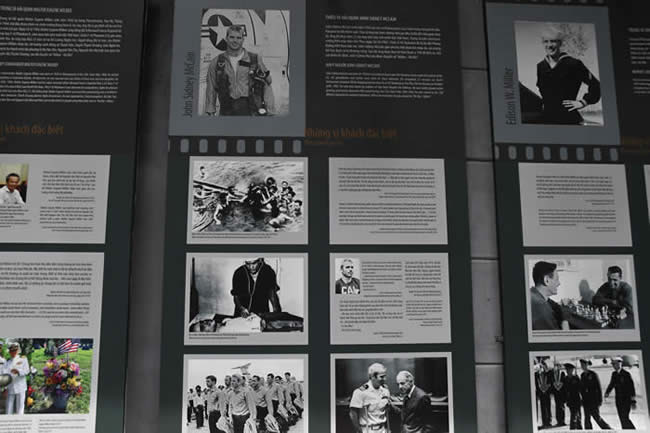
© 2018 Callyn Yorke
Bridge for Peace exhibit , Hoa Lo prison 7 July 2018

© 2018 Callyn Yorke
Cuc Phuong National Park and Ninh Binh Province (7/9-13)
Mac Lake, Cuc Phuong National Park 9 July 2018
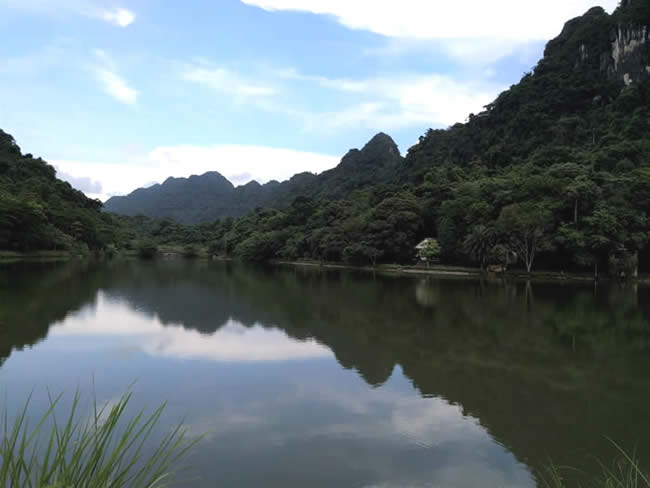
© 2018 Callyn Yorke
Da Thao and I hired a taxi for a three-hour drive from Hanoi to Cuc Phuong National Park. It was raining most of the way, including torrential downpours which resulted in almost zero visibility on the roadways. Our driver, Tang, nonetheless, ploughed through it and we arrived at the Cuc Phuong Resort about midday. The resort had some trees, flowering shrubs, lawns and water features that appeared to be attractive to birds. A couple of families were about the only guests we could see. Everything was fine here, clean rooms, dining area, large open areas for birding.
However, we soon discovered that the resort, located about 2 km outside the national park, had very little birdlife. A few sunbirds visited the flowering shrubs outside the dining hall, but that was about it. Evidently, most of the property was regularly sprayed with chemicals in order to protect the lawns, trees and visitors from unwanted pests. The resort, in fact was little more than some bungalows and other buildings arranged around an unused, but well-manicured golf course. Further, since it was the low season, the dining area was all but closed at mealtimes, offering a minimal selection of left-over fruit and packaged food. We checked out the following morning.
Accomodations inside Cuc Phuong National Park weren't much better. We settled on a small, dormitory-style room at the park headquarters. Rooms and dining facilities further into the park were less appealing. In short, we found no decent choices for lodging while visiting Cuc Phuong National Park.
On that cheerful note, we proceeded to obtain information from park officials regarding accessing the forest and finding some birds. There were four options available to us: 1) Walk the 3 km Botanic Garden Trail, beginning and ending at the park headquarters. 2) Walk the main paved road through the park. 3) Hire a motorbike and drive the paved roads through the park. 4) Hire a park guide and follow him around on the motorbike.
Da Thao on the Botanic Garden Trail, Cuc Phuong National Park 10 July 2018

© 2018 Callyn Yorke
We chose three of the four options over the course of our four-day visit in the park. First, we made a 2.5 hr, survey of the "Botanic Garden" Trail (largely without plant labels), which produced a few interesting birds, e.g. a pair of Rachet-tailed Treepie, but was actually better for butterflies, orthopterans, walking sticks and lizards, than birds. Much of the BG trail traversed second-growth, ruderal patches and woodland plantations; forested sections in limestone outcrops appeared nearly birdless. Walking the main roads was most productive in and around park headquarters, where birds were relatively habituated to humans and safe from hunters and trappers. In fact, the best birding when on our own, was found close to our accomodations.
Ratchet-tailed Treepie (Temnurus temnurus) Cuc Phuong National Park 10 July 2018
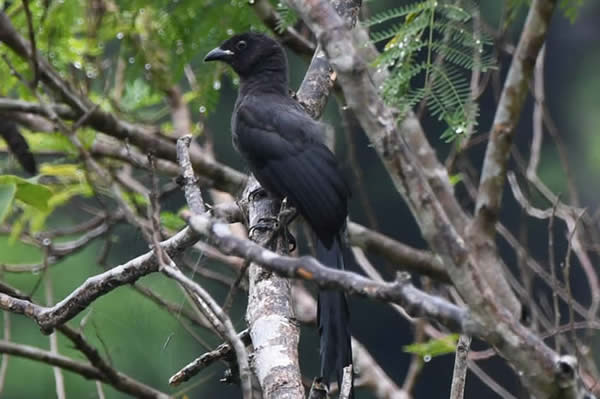
© 2018 Callyn Yorke
Glassy Tiger (Parantica aglea) Cuc Phuong National Park 10 July 2018
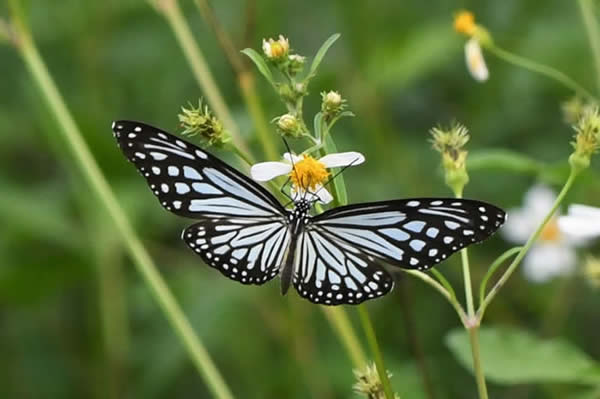
© 2018 Callyn Yorke
Gray Pansy (Junonia atlites) Cuc Phuong National Park 10 July 2018
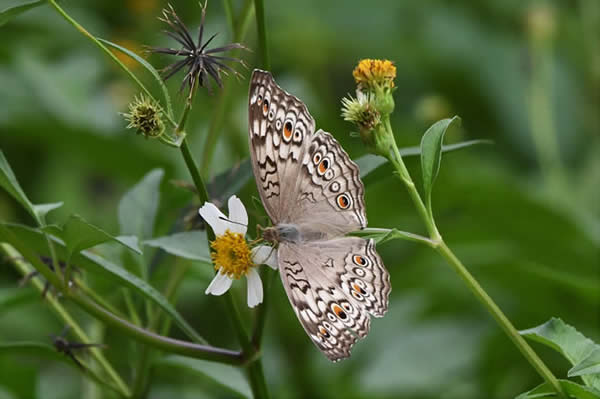
© 2018 Callyn Yorke
Dark Blue Tiger (Tirumala septentrionis) Cuc Phuong National Park 10 July 2018
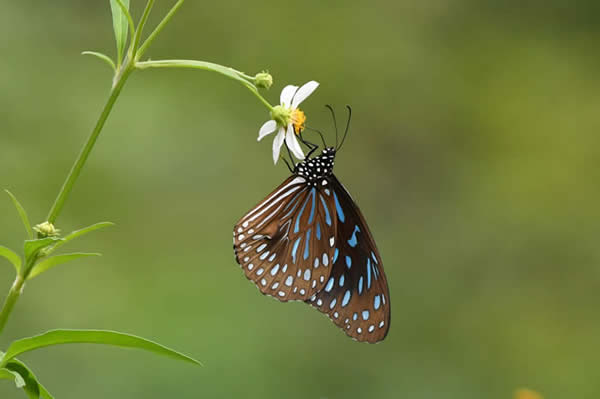
© 2018 Callyn Yorke
Giant Bush Cricket (Sanaea intermedia) Cuc Phuong NP 10 July 2018
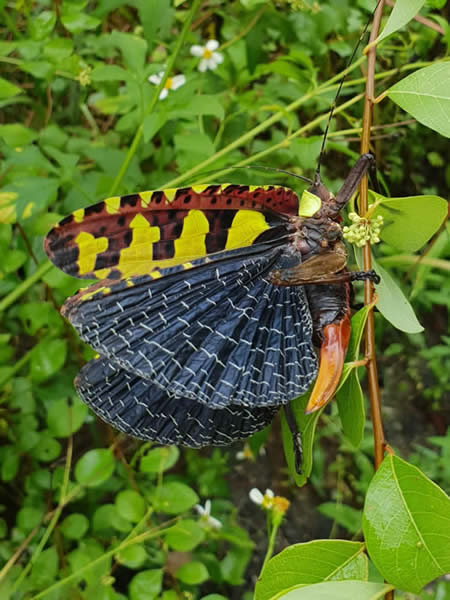
© 2018 Callyn Yorke
Giant Walking Stick (Phryganistria sp.) Cuc Phuong NP 11 July 2018
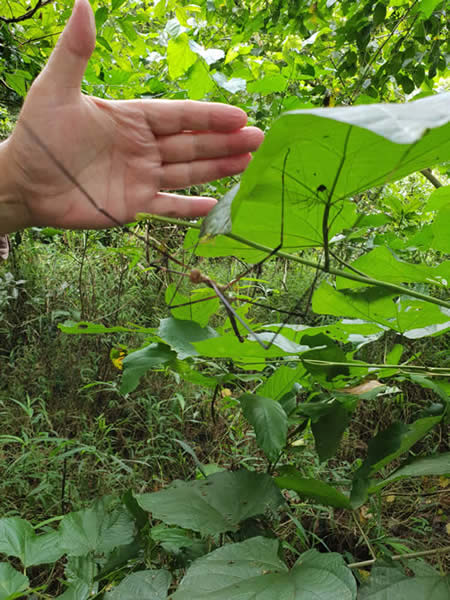
© 2018 Callyn Yorke
Calotes sp. Cuc Phuong National Park 11 July 2018

© 2018 Callyn Yorke
One morning, we hired a park guide, Mr. Huyen, and set off on motorbikes along the main park road to a few select birding sites. Stopping frequently, we walked along the roadway and some distance on forest trails in search of birds. Huyen used a recorder to playback the vocalizations of local birds but without much success. An exception to this, however, was one very special bird in the region, Limestone Wren-Babbler. Huyen's persistent playbacks of its song, eventually paid off, as we caught brief glimpses of a single bird working its way up a limestone stairway leading to an archaelogical site. Although, the poor lighting and distance prevented me from obtaining anything more than a blurry image of the bird, it was a legitimate lifer for Da Thao and I. We returned to the same location with improved lighting conditions on the way back to park headquarters, but the bird could not be relocated. Huyen always made a galant effort to locate birds for us. Yet, after several hours of active birding in the park, we came up with a day-list of only twenty-six species.
While in transit, Huyen spotted two very cooperative birds of prey, Black Eagle and Pied Falconet. The latter was busy consuming a small passerine atop a tall, leafless tree. I eagerly documented the falconet (another life-bird) with a series of distant yet redeemable images..
Pied Falconet (Microheirax melanoleucos) Cuc Phuong NP 11 July 2018
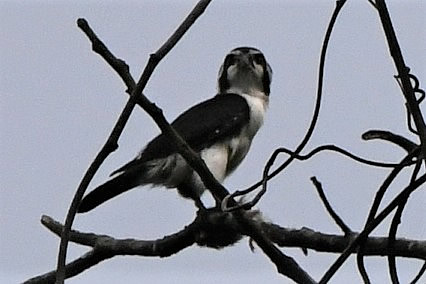
© 2018 Callyn Yorke
Crested Serpent Eagle (Spilornis cheela) Cuc Phuong National Park 11 July 2018

© 2018 Callyn Yorke
Huyen and I discussed the apparent paucity of birdlife found in Cuc Phuong during our visit. He attributed this to a combination of seasonality (birds are mostly quiet during the summer nesting season) and poaching. Local tribesmen living in the park routinely hunt and trap birds and other animals. This has been a tradition for them for generations before the area was designated a national park by President Ho Chi Minh in 1962. Evidently, little has been done little to manage the situation, i.e. re-education and cultural assimilation, which would require substantial manpower and financial commitment.
Gia Vien District, Ninh Binh Province (7/12)
Trang An
Bai Dinh Pagoda
Van Long Nature Reserve
Side Roads
Ninh Binh Province outside Cuc Phuong National Park 9 July 2018
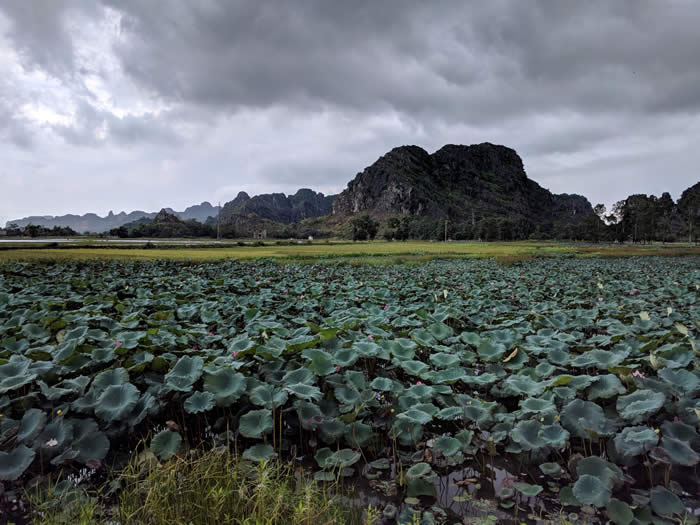
© 2018 Callyn Yorke
This was a dusk to dawn excursion in a privately hired car from Cuc Phuong National Park to three principal tourist attractions in the region. Our first destination was Trang An. We arrived around 0900 hrs. and purchased boat tickets for a tour. Since it was low season, only a few hundred tourists were present. The tour company operating the concessions and boats maintained about 2,500 boats moored around the main island; most were empty this morning.
Trang An rowboat tour 12 July 2018

The row boats are handled by local women who are paid about $2 per day. Competition is fierce for jobs among the villagers. Our rower told us (Da Thao translated) that she considered herself very fortunate to be working today. All of these Vietnamese women resolutely bear the burden of constant rowing of the small, shallow skiffs, often loaded with overweight tourists.There are short, medium length and extended tours; the average is about three hours, through several kilometers of waterways and caves. On slow days, the women organize rowboat races for amusement and special prizes (early retirement?).
Trang An - exiting a limestone cave 12 July 2018
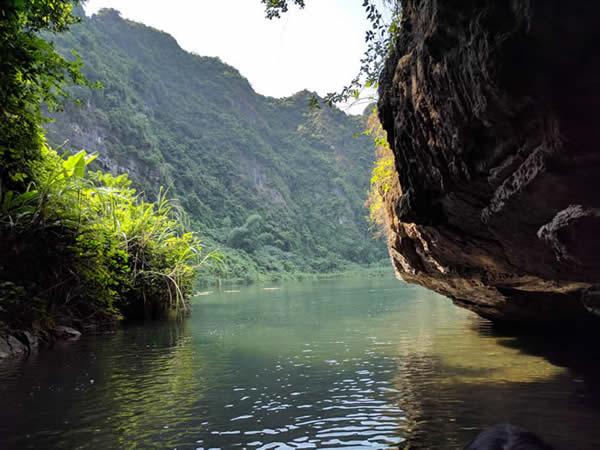
© 2018 Callyn Yorke
Although our boat tour passed a series of forested hills and cave entrances, birdlife was largely absent. Perhaps it was rather too late in the morning. There appeared much suitable habitat throughout the park, but silence prevailed except for the occasional shreaks and shouting of tourists entering caves. No bats or swiftlets were seen in the caves. After about the first hour of the tour it was clear we didn't need our binoculars for wildlife viewing; there was nothing of zoological significance that we could find.
The tour took a 45-minute break on Kong Island, a movie set for the recent Hollywood blockbuster, including a mock-up US Navy boat and spear-bearing tribesmen. That was apparently the highlight of the tour for most of the visitors, who jostled for portraits. The celebrities, along with the local wildlife and aboriginal tribes, had long since vanished. Kong Island also had a picturesque pagoda, largely ignored by the crowds of tourists, that provided an interesting setting for photos.
Trang An Monastery 12 July 2018

© 2018 Callyn Yorke
Bai Dinh Pagoda 12 July 2018

© 2018 Callyn Yorke
By the time we finished the boat tour at Trang An the midday heat had reached about 95F. Consequently, when we arrived at Bai Dinh Pagoda, it wasn't optimal for birding. Actually, it wasn't optimal for anything other than fanning oneself in the shade. We climbed up to the bell tower, obtained a few snapshots of the fine architecture and scenery of this, the largest and most famous pagoda in Vietnam, then shuffled back to the car waiting for us in the parking lot. If there was any birdlife in the manicured gardens and orchards of Bai Dinh, we failed to appreciate it. A couple of bulbuls (sp?) flew by and vocalized in the orchard. So much for birding Bai Dinh.
Van Long Nature Reserve, Ninh Binh Province 12 July 2018
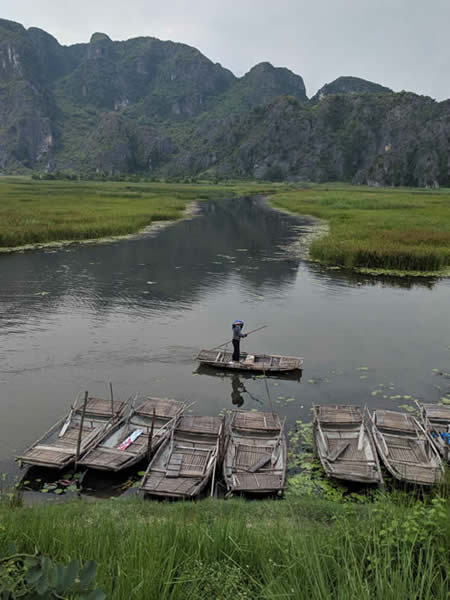
© 2018 Callyn Yorke
The heat and humidity greeted us with staggering intensity at Van Long. Most of the tourists had come and gone. The boat ladies and everyone else in the adjacent village were on siesta. Rather than be exposed to the blazing sun for several hours in a small boat, we chose to relax for a couple of hours in the shaded hammocks of a nearby concession stall. That turned out to be a wise move.
We boarded a rather unsteady, raft-boat later that afternoon, and began a leisurely journey through a maze of waterways, marshes and caves covering an area of more than 100 hectares. Very soon after leaving the dock we spotted a critically endangered primate endemic to the region, Delacour's Langur. Only about 200 individuals of this species remain in the wild, confined to nine localities in North Vietnam. A female and her offspring were bounding over the limestone walls as though there was no risk at all from falling 50m or more into the marsh. Evidently, these agile primates, most active in the cooler morning and afternoon hours, spend their entire lives scampering over precipitous limestone outcrops, feeding on patches of vegetation growing from soil and moisture trapped in the jagged crevices. Seeing this rare and handsome primate was unquestionably the highlight of our visit to Van Long.
Delacour's Langur (Trachypithecus delacouri) adult female Van Long Reserve 12 July 2018

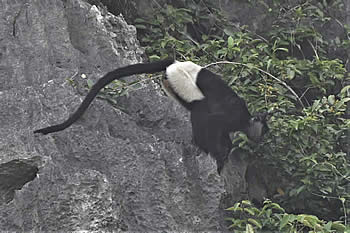
© 2018 Callyn Yorke
We also found a few interesting birds at Van Long that were new for our trip list, such as both Bronze-winged and Pheasant-tailed jacanas, Common Moorhen and Plain Prinia. Our boat lady-captain mentioned that early mornings were best for finding birds at Van Long. Unfortunately, we were scheduled for a long drive the following day to Sa Pa, located near the Chinese border in northwest Vietnam. The Van Long Reserve would have to go on our list of places to revisit in the near future.
Plain Prinia (Prinia inornata) Van Long Reserve 12 July 2018

© 2018 Callyn Yorke
Van Long Reserve, Ninh Binh Province 12 July 2018

© 2018 Callyn Yorke
Ninh Binh Province, Northern Vietnam 12 July 2018
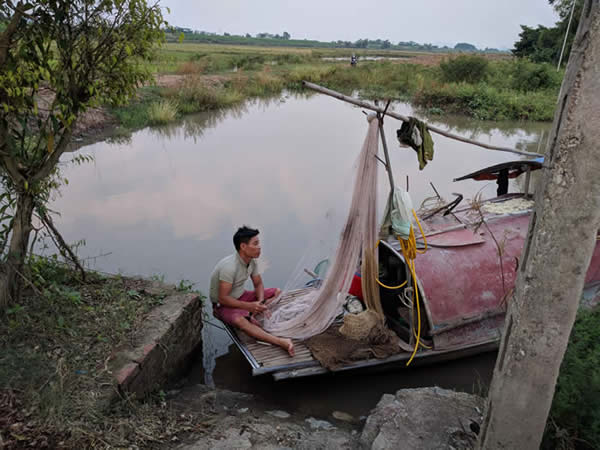
© 2018 Callyn Yorke
There was about an hour of daylight remaining following our tour of Van Long. Several days earlier, as we approached Cuc Phuong, we noticed a distant river bordered by tall trees contaning egrets and herons. It had been too far away to identify the birds to species. This afternoon however, there was another opportunity to drive on a side road through a Gia Vien village paralleling the heronry. Our early evening timing was perfect. Hundreds of birds were returning from the fields and alighting in the trees.
Even in the fading daylight we were close enough this time to identify almost all of the birds. Some were new for our trip list, including two landbirds in the roadside shrubs (Cinereous Tit and Light-vented Bulbul). Here is a partial list of birds found at this location after about 20-minutes of observation at dusk.
Cinnamon Bittern
Black-crowned Night Heron
Chinese Pond Heron
Cattle Egret
Grey Heron (?)
Little Egret
Pheasant-tailed Jacana
Swallow sp.
Cinereous Tit
Lonchura sp.
Light-vented Bulbul
Sooty-headed Bulbul
Cisticola sp.
This was one of the birdiest locations we found in Ninh Binh Province, yet it was not mentioned in any of the online reports for the region.
A mutti-species heronry, showing roosting Little Egret (Egretta garzetta) Ninh Binh Province, 12 July 2018
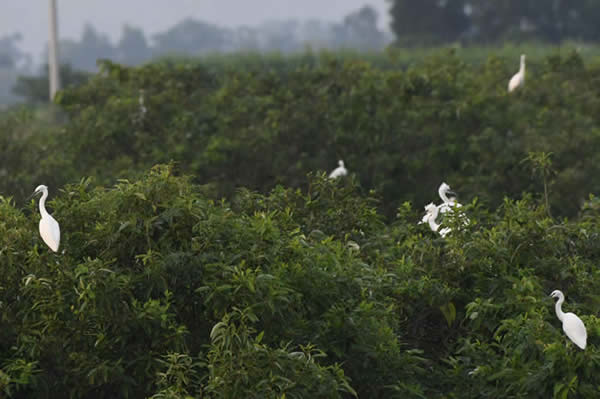
© 2018 Callyn Yorke
Cinereous Tit (Parus cinereus) Gia Vien, Ninh Binh Province 12 July 2018

© 2018 Callyn Yorke
Light-vented Bulbul (Pycnonotus sinensis) Gia Vien, Ninh Binh Province 12 July 2018
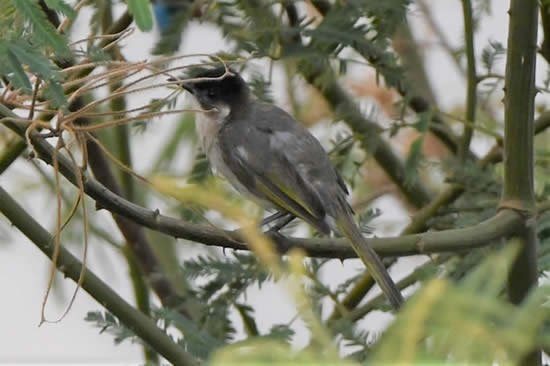
© 2018 Callyn Yorke
Gia Vien District , Nihn Binh Province 12 July 2018
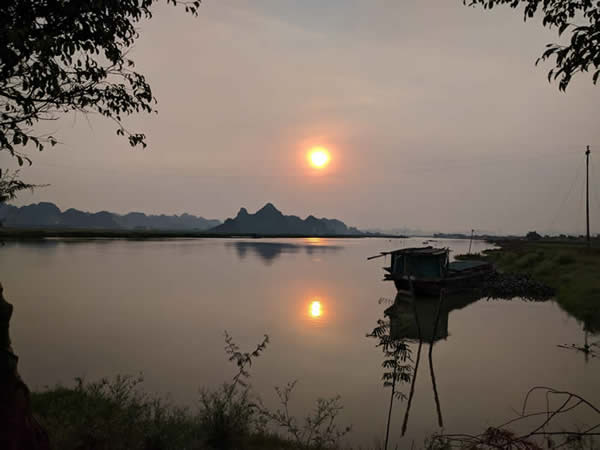
© 2018 Callyn Yorke
Sa Pa, Lao Cai Province (7/13-17)
Hmong woman, Sa Pa 15 July 2018
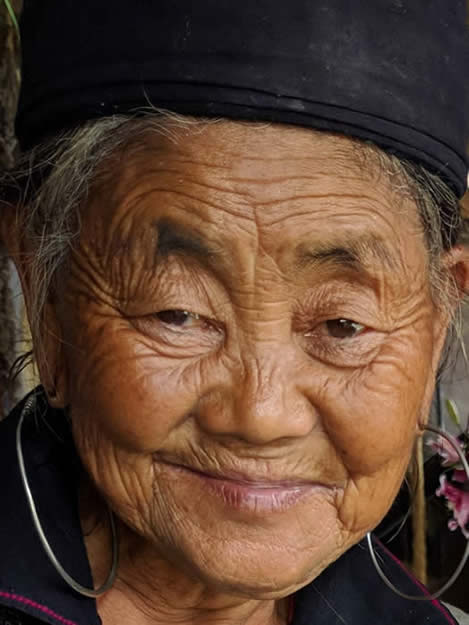
© 2018 Callyn Yorke
Lower slopes of Mt. Fansipan, Sa Pa 14 July 2018
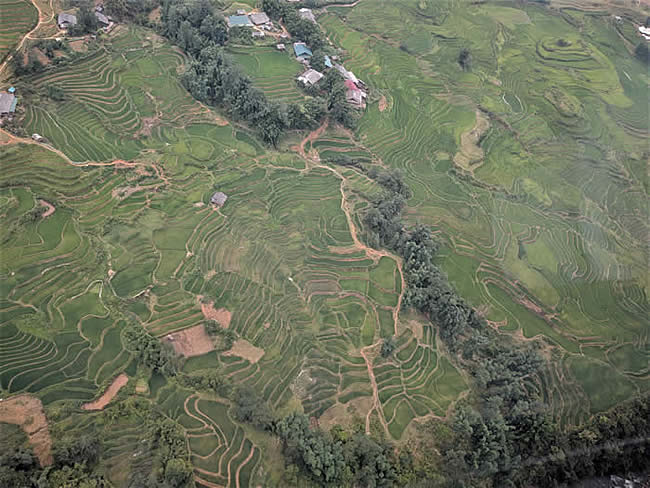
© 2018 Callyn Yorke
We arrived in the bustling highland community of Sa Pa late in the afternoon without a hotel reservation. No worries. There were many hotels in town with vacancies. New construction was everywhere. We visited a few hotels and eventually settled in one across from a scenic lake near the center of town. The cool mountain air was a refreshing change from the lowlands of Ninh Binh. High mountain ridges surround the chic, touristy town, which seemed a bit like Kathmandu trying to become Aspen, Colorado.
Without current online birding reports Sa Pa was an enigma for us. Very little natural habitat remains on the surrounding slopes; much of it having been converted to agriculture terraces, e.g. rice paddy. The central market was chirping with an astonishing variety of caged birds, evidently originating from the local mountains. We hired a taxi to drive us around in search of any remaining highland forest that might be accessible. Eventually, we found the entrance to Love Waterfall, a popular park that appeared to include a significant montane rainforest.
Love Waterfall, Sa Pa 16 July 2018
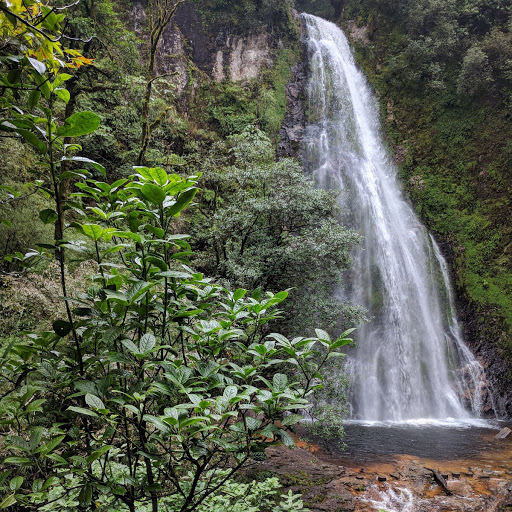
© 2018 Callyn Yorke
Good forest habitat was plentiful along the narrow trail toward the waterfall. Also abundant were parties of tourists -- so loud in some cases, that we had difficulty identifying bird vocalizations. About half way down the main trail we took an overgrown side trail leading to an open meadow and stream. It was quiet but not really the wilderness full of life-birds we hoped to find. We stood still patiently for twenty minutes or so before the first signs of birdlife appeared. A young man carrying bird-trapping equipment scurried by us and disappeared into the forest.
A bird suddenly began vocalizing somewhere very nearby. I scanned the canopy and forest middle story but the songster was nowhere to be seen. Its song was short in duration, sharply accented with variable notes, loud and repetitive. I recorded it with my cell phone and played it back a few times. The bird responded and briefly appeared within a few meters of us, suprisingly, nearly at ground-level. It was gone in an instant and not seen again, despite several rounds of playback recordings. What I saw of it, suggested a small, brownish passerine with a short tail. Subsequently, a search of the field guide books, online bird photos and sounds, left only one possibility for its identity: Lesser Shortwing (Brachypteryx leucophris). Further down the trail near the waterfall, two or three more of these birds were heard. As with the first one we encountered, none was visible.
The rainforest at the bottom of the trail next to a large, swift flowing stream, produced a series of mixed species flocks. Among the more conspicuous birds were two nuthatches, Chestnut-vented and Chestnut-bellied Nuthatch, the latter a lifer for us. Other delighful surprises in entriely different mixed species flocks, were Yellow-cheeked Tit and Rufous-winged Fulvetta.
Chestnut-vented Nuthatch (Sitta nagaensis) Love Waterfall 14 July 2018 Chestnut-bellied Nuthatch (Sitta castanea) Love Waterfall


© 2018 Callyn Yorke
Yellow-cheeked Tit (Machlolophus spilonotus ) LW 14 July 2018 Rufous-winged Fulvetta (Schoeniparus castaneceps) LW
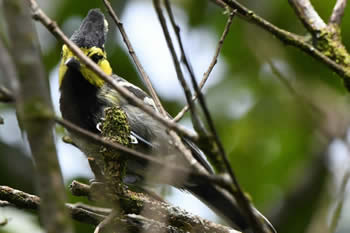
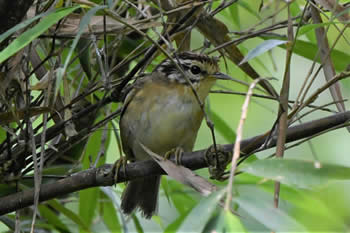 © 2018 Callyn Yorke
© 2018 Callyn Yorke
In addition to a fairly diverse avifauna, the Love Waterfall park included many interesting trees, quite a few with labels. The following is a partial list of trees found mostly along the main trail. Interestingly, as with birds, there are some genera represented by similar species in temperate North America, e.g. Acer, Prunus and Quercus.
Acer flabellatum
Castanopsis lecontei
Carmela sp.
Daphniphyllum chartaceum
Elaeocarpus griseopuberulus
Gordonia axillaris
Huodendron tibeticum
Ilex chapaensis
Ilex macrocarpa
Illicium majus
Illicium tsai
Lithocarpus hancei
Machilus macrophylla
Neolitsea alongensis
Prunus cerasoides
Prunus phaeosticta
Quercus petelotii
Rhododendron sp.
Styrax tonkinensis
The forests in the Sa Pa region doubtless held an even greater variety of birds than we observed at Love Waterfall during two separate visits. Some of those species were for sale as caged birds in the town square. One morning we browsed the caged bird display and found the following five species which we had not yet seen in the wild.
Chinese Francolin (Francolinus pintadeanus)
Streak-breasted Scimitar Babbler (Pomatorhinus ruficollis)
Black-throated Laughingthrush (Garrulax chinensis)
Red-tailed Laughingthrush (Trochalopteran milnei)
Silver-eared Mesia (Leiothrix argentauris)
Chinese Francolin (Francolinus pintadeanus) caged bird market Sa Pa 15 July 2018
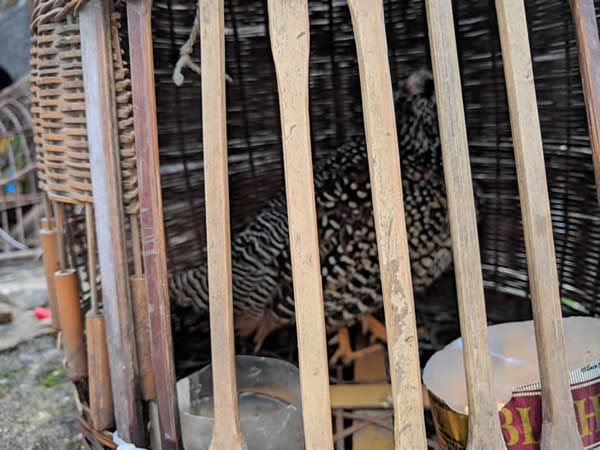
© 2018 Callyn Yorke
Streak-breasted Scimitar Babbler (Pomatorhinus ruficollis) Sa Pa 15 July 2018
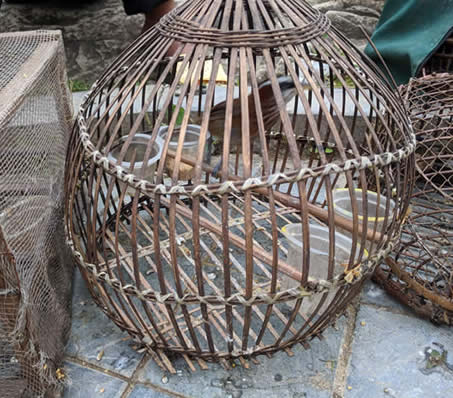
© 2018 Callyn Yorke
A side trip after birding at Love Waterfall park brought us to Fansipan Mountain, which at 3,145 m, ranks it as the highest mountain on the Indochinese Peninsula. Although there were forest covered slopes leading to the summit, we observed little birdlife. The mountain scenery alone was worth the effort, which was breathtaking, especially on the final staircase leading to the summit. Throngs of Buddhist devotees scrambled up the stairs and huddled in the chilled fog for photos. For many like Da Thao, this was the pilgrimage of a lifetime.
A view from the summit of Fansipan 14 July 2018
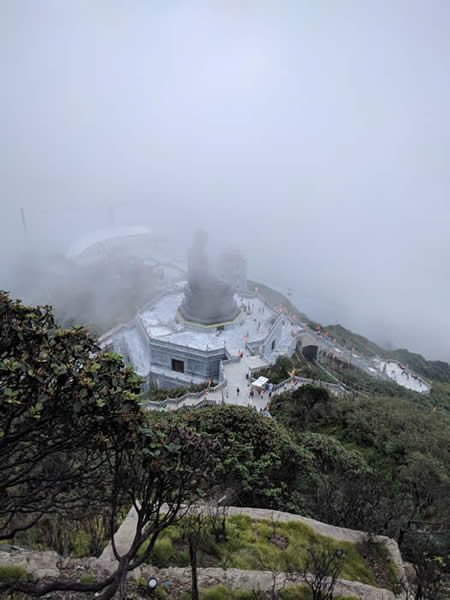
© 2018 Callyn Yorke
Later that afternoon we visited Cat-Cat village on the outskirts of Sa Pa. This was a highly commercialized, rather pricy walking tour ($10 pp), advertised as a comprehensive cultural experience with the local Hmong people. We hoped to see some birds along the path paralleling a large, swift stream. Not much to see there but a small family of Plumbeous Water Redstarts flying back and forth to boulders and brush piles in and around the stream.
Plumbeous Water Redstart (Rhyacornis fuliginosa) Cat Cat Village, Sa Pa 14 July 2018
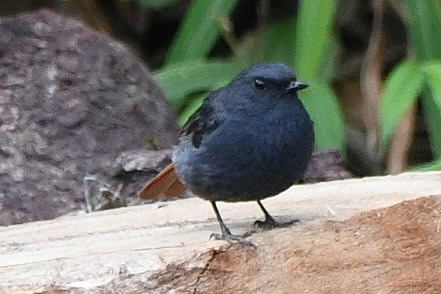
© 2018 Callyn Yorke
As for a cultural experience, I'm afraid that was almost as unproductive as the birding. The village was nothing more than a series of makeshift stalls with handicrafts for sale, the likes of which were easily obtained on the streets of Sa Pa. There was absolutely no information provided regarding an authentic mountain village lifestyle. The tour was a sham.
Stream running through Cat Cat village, Sa Pa 14 July 2018
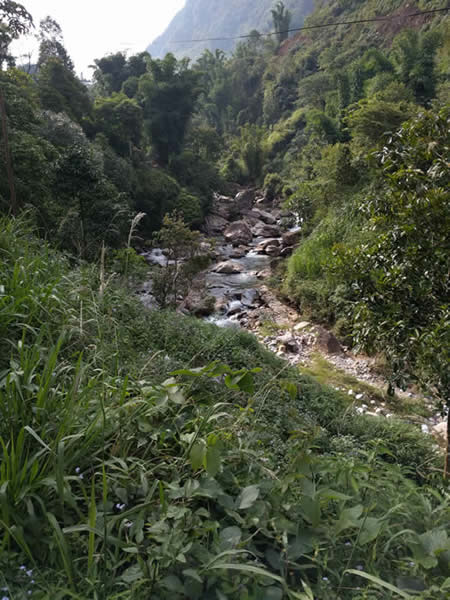
© 2018 Callyn Yorke
Nonetheless I managed to get a couple of quick photos of some sharp-eyed children, before they noticed me aiming a Nikon 500mm lens at them from a comfortable distance. Unfortunately, candid shots of these colorfully attired folks are almost impossible to obtain; tourist photography has become a local business for them. Kids have learned to demand, "Wan Dolla" from everyone carrying a camera. There were many more excellent photo opportunities at the market in town, rather than along the crowded trail through the Hmong "village."
Hmong children of Cat Cat village, Sa Pa 14 July 2018
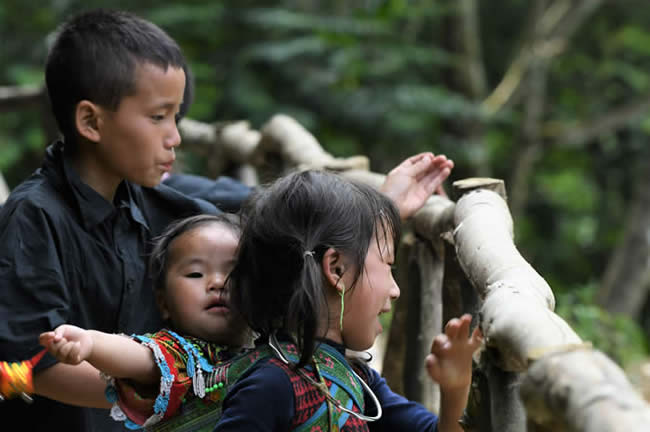
© 2018 Callyn Yorke
Central Vietnam (7/20-30, 2018)
Da Nang
Hue
Bach Ma National Park
DMZ
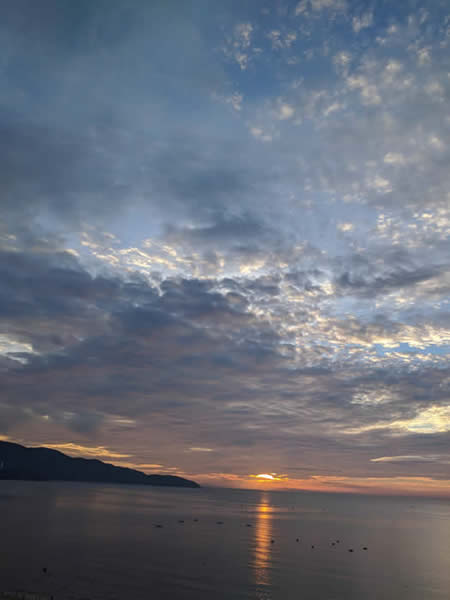
© 2018 Callyn Yorke
Da Nang is one of the most popular tourist destinations in Vietnam. And for good reason. It boasts an international airport (a former US Air Base), beautiful beaches, luxury resorts, mountain scenery, fine restaurants and wildlife viewing areas which are all easily accessible. An excellent birding location was within a 10-minute taxi ride from our beachside hotel: Son Tran Mountain.
Da Nang and Linh Ung Monastery (white statue) on Son Tran Mountain 21 July 2018
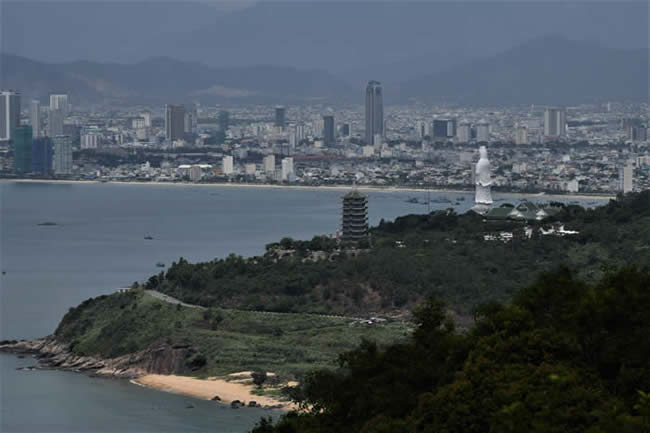
2018 Callyn Yorke
Son Tran Mt., which overlooks the main beach lined with high-rise hotels, has retained native vegetation (most of it second-growth) characterizing the coastal rainforest ecosystem of Vietnam. Dubbed 'Monkey Mountain' by U.S. soldiers (presumably due to a resident population of Rhesus Macaque), Son Tran was a major American radar installation during the war and off-limits to civilians. After the war the Vietnamese government declared the entire area a wildlife sanctuary, a status it retains, albeit precariously. Recently, Da Nang has been targetted for development as a major shipping port. We shall soon see how such an ambitious project impacts this important coastal ecosytem. Presently all is quiet on Son Tran Mt..
Rhesus Macaque (Macaca mulatta) Linh Ung, Son Tran Mt. Da Nang 22 July 2018

© 2018 Callyn Yorke
We made several trips on two converging paved roads traversing Son Tran Mt., including visits to the Linh Ung monastery. Nearly everywhere along the road we found interesting birds and wildlife, e.g the stunning Red-shanked Douc was fairly common in the forest covering the north side of the mountain. Birds and other wildlife were generally skittish along the mountain roadway but relatively tame at the Linh Ung monastery, where the best photo opportunites were consistently found.
Dark-necked Tailorbird (Orthotomus atrogularis) Linh Ung, Son Tran Mt. 26 December 2018
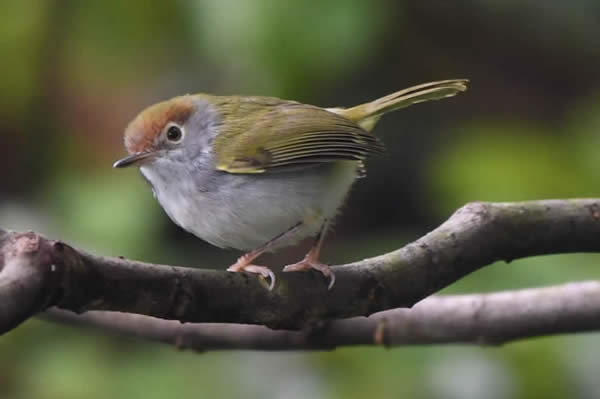
© 2018 Callyn Yorke
Crested Goshawk (Accipiter trivirgatus) Linh Ung Monastery, Son Tran Mt. Da Nang 30 July 2018

© 2018 Callyn Yorke
Red-shanked Douc (Pygathrix nemaeus) Son Tran Mt. Da Nang 21 July 2018
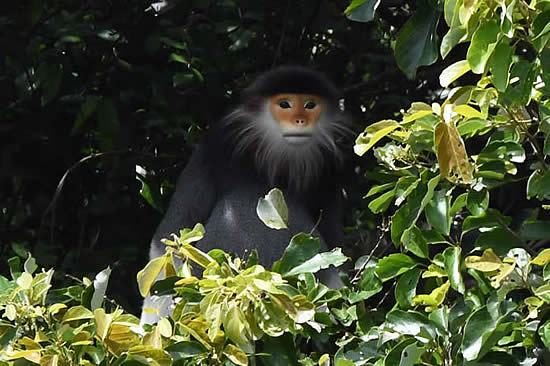
© 2018 Callyn Yorke
If you are spending a few days in Da Nang there are several nearby locations worth visiting, including the historic town of Hoi An, about 45-minutes by taxi from central Da Nang. We have been there several times and always found something new and interesting in the art shops. The historic section of town is closed to automobile traffic in the evenings, when the place comes alive with a kaleidoscope of lights, floating candles, live rock n' roll, and boatloads of tourists.
Da Thao Nguyen in Hoi An 21 July 2018

© 2018 Callyn Yorke
Model ship store Hoi An 21 July 2018
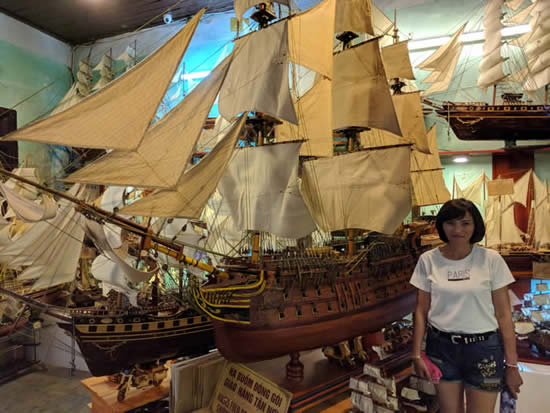
© 2018 Callyn Yorke
Fairly good birding opportunites were found in the historic Imperial City of Hue, located about 2-hours by car (3 hrs. by train) north of Da Nang. The old, brick-walled citadel is about the size of Disneyland, with comparable multinational crowds. Much of the city has been restored following a fierce battle (Battle of Hue) fought there during the American War.
Riverfront of Hue, viewing north over the Perfume River to the Imperial City of Hue
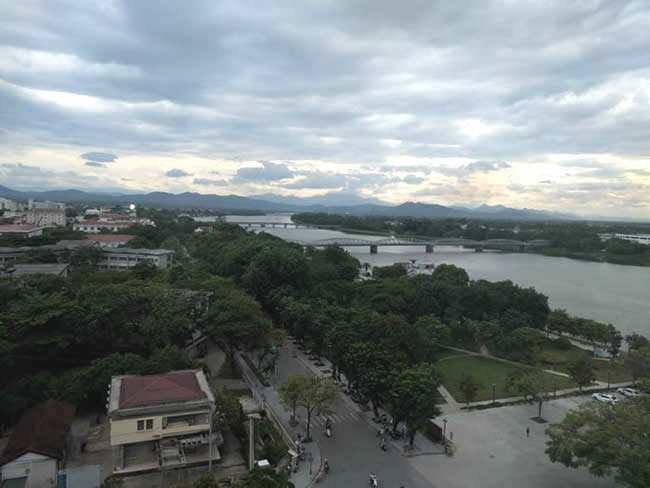
© 2018 Callyn Yorke
Battle scars from the American War Imperial City of Hue 24 July 2018
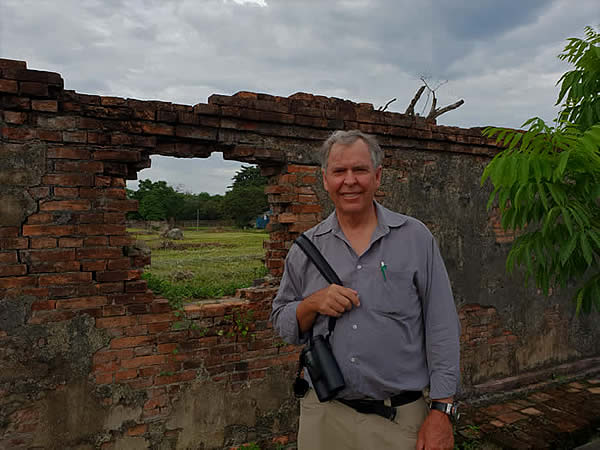
© 2018 Da Thao Le Nguyen
Imperial City of Hue 24 July 2018
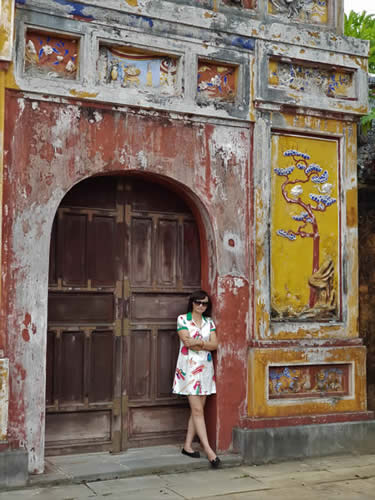
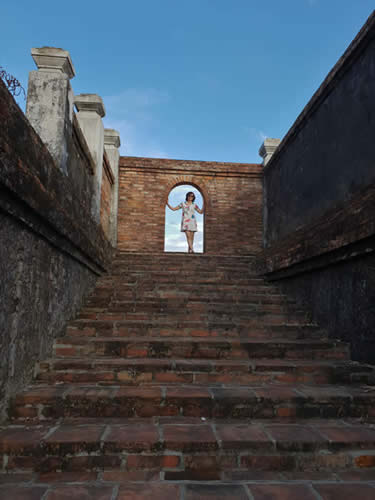
© 2018 Callyn Yorke
We chose to do a self-guided walking tour of the citadel during the last two hours it was open to the public, 3-5 PM. It was a good choice for two reasons: The searing daytime temperatures had abated and fewer tourists were present. The result was that we could stroll peacefully on the stone pathways through a maze of weedy fields, gardens and crumbling ruins, just as the local birdlife appeared to be awakening from a mid-day siesta. Highlights included Germain's Swiflet and White-shouldered Starling -- both lifers for Da Thao.
In terms of pristine rainforest, mountain scenery and bird diversity, no place surpasses Bach Ma National Park, located about 1.5 hrs south of Hue on the main highway. There's only one drawback: Rain, tons of it. Averaging 8m of annual rainfall, Bach Ma may be the wettest place on the Indochinese Peninsula. If you intend to do any birding and photography you best show up with adequate rain gear.
We made two visits there, one week apart. The first trip was nearly rained out. Indeed, a day without rain on Bach Ma Mountain is probably unusual, even in the "dry" season. We ended up dripping wet and without a clue where to find birds.
View from the summit of Bach Ma Mountain, Bach Ma National Park 20 July 2018
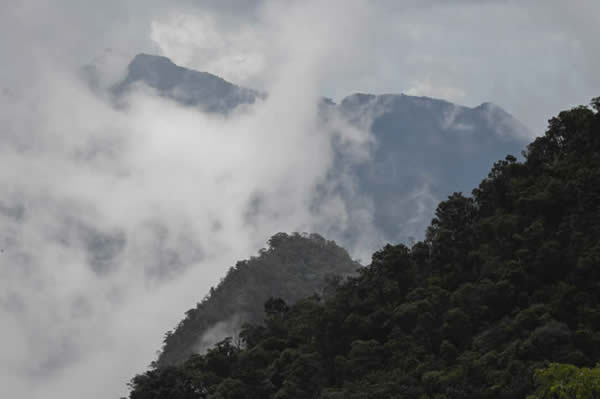
© 2018 Callyn Yorke
Our second visit included a local guide, Quy Minh, who was a last-minute substitution. Unsure what to expect from the unannounced change in personnel, we proceeded up the mountain with Quy Minh riding shotgun in our SUV. We made several stops and birded the forest edge of the roadway. Unlike our first visit, we did not venture far into the forest. That was unnecessary. There was an abundance of birdlife at all elevations in and outside the park along the roadway. Additionally, intermittent rains meant we would frequently need to take shelter in the vehicle.
Within seconds after exiting our vehicle at each stop Quy Minh announced several new birds for us. Most notably, at an elevation of about 800 m, there was a Short-tailed Scimitar Babbler skulking near the ground in the undergrowth next to the roadway. Quy Minh continued playing its song on his recorder and soon the bird briefly appeared in a small clearing. It was barely at the focal limit of my Nikon 200-500mm lens (about 3m) and I managed three quick shots before it disappeared. This was unquestionably the rarest bird we found in Bach Ma; a seldom-seen species that is endemic to the mountains of central and southern Vietnam.
Short-tailed Scimitar Babbler (Jabouilleia danjoui) Bach Ma National Park
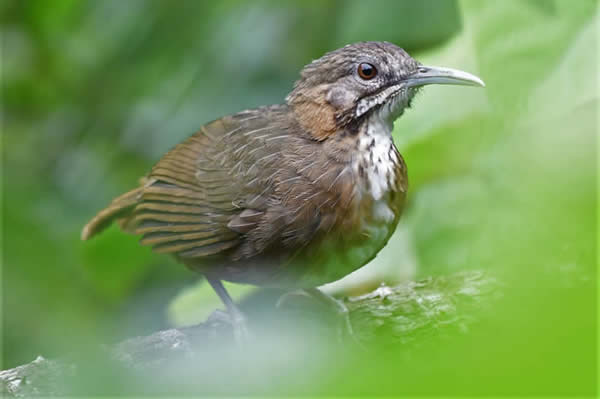
© 2018 Callyn Yorke
Quy Minh knew many bird vocalizations and pointed out a number of species calling that we never saw, e.g. Annam Partridge, Indochinese Green Magpie, Black-throated Laughingthrush and White-browed Scimitar Babbler. This was a bit frustrating, along with intermittent showers. To make matters worse, my binocular clip-strap broke, sending my binocular directly to the pavement and knocking one of the lenses completely out of adjustment. Now I was like a 17th century seafarer trying to identify a distant albatross with a foggy monocular. I ended up tossing the useless binocular back into the car and relying solely on my camera. That worked out surprisingly well mainly because Quy Minh identified nearly every visible bird, leaving me free to simply aim, focus and shoot.
Red-headed Trogon (Harpactes erythrocephalus) Bach Ma National Park 27 July 2018
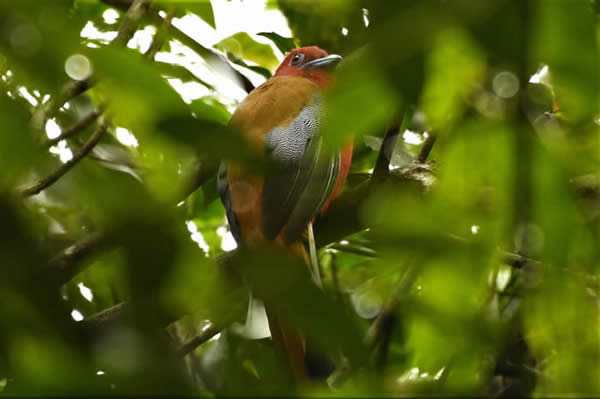
© 2018 Callyn Yorke
Chestnut- collared Yuhina (Yuhina torqueola) Bach Ma National Park 27 July 2018

© 2018 Callyn Yorke
We spent a few minutes during an earlier visit to Bach Ma, enjoying the scenery at the summit, where there was an old French house converted into a small museum. Several backpackers were relaxing on the roof. I walked around the decking looking for the best scenery shot. There were several good choices; the view was splendid in all directions as the low clouds, squalls and fog embraced the rugged landscape.
View from the summit of Bach Ma Mountain 20 July 2018
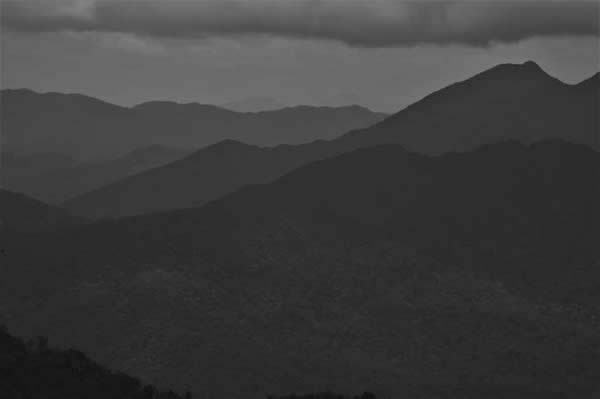
© 2018 Callyn Yorke
A 1967 US $0.25 coin I received with some change in Lancaster, California in September, 2018
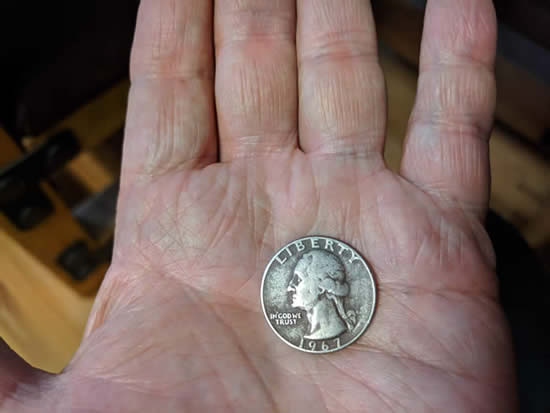
© 2018 Callyn Yorke
I am not an avid coin collector and know very little about the hobby. But when I received an old quarter with some change the other day, I noticed it was minted in 1967. Staring at it for a few seconds, I imagined how many, many lives had been touched by this 51-year-old coin, and wondered what had been each owner's fate. Perhaps a US Marine in Vietnam? An anti-war activist? A farmer, a factory worker, a lawyer, politician, bank robber? Hundreds, perhaps thousands of folks once received this coin as change, just as I had. This old quarter-dollar traveled through some pretty heavy world history... now surfacing as a slightly tarnished icon of mysterious, unwritten, unrelated stories; like an indecipherable message-in-a-bottle found washed up onshore, or a blank chain-letter. For some reason, I felt compelled to keep it, rather than drop it into my spare change jar. Putting away the coin seemed like saving an unlabled black-and-white photo of relatives who died before I was born; it was a way to capture a magical moment of unknown convergent histories.
1967 was a time of intense fighting in Vietnam, particularly in the mountains around the DMZ and Laotian border. The combat bases at Khe Sanh and Con Thien experienced lethal NVA artillery and mortar attacks. In April, 1967, firefights were breaking out on hilltops throughout the area, e.g Hill 861, 881N and 881S (significant hills were identified by their elevation). U.S. commanders believed a big NVA offensive was about to take place and began reinforcing the combat bases around the DMZ, nicknamed the "Dead Marine Zone." Things went from crazy to surreal. An American journalist in the field, Michael Herr, describes the way US combat soldiers coped with the insanity of war:
Flip religion, it was so far out, you couldn't blame anybody for believing anything. Guys dressed up in Batman fetishes, I saw a whole squad like that, it gave them a kind of dumb esprit. Guys stuck the ace of spades in their helmet bands, they picked relics off of an enemy they'd killed, a little transfer of power; they carried around five-pound Bibles from home, crosses, St. Cristophers, mezuzahs, locks of hair, girlfriends' underwear, snaps of their families, their wives, their dogs, their cows, their cars, pictures of John Kennedy, Lyndon Johnson, Martin Luther King, Huey Newton, the Pope, Che Guevara, the Beatles, Jimi Hendrix, wiggier than cargo cultists. One man was carrying an oatmeal cookie through his tour, wrapped up in foil and plastic and three pair of socks. He took a lot of shit about it ("When you go to sleep we're gonna eat your fucking cookie"), but his wife had baked it and mailed it to him, he wasn't kidding. - Michael Herr, Dispatches, 1977, Alfred A. Knopf, New York, pp 52-53.
U.S. bombing of North Vietnam, code name Rolling Thunder, was also in full-swing at this time. On October 26, 1967, Lieutenant Commander John S. McCain III, was captured by the NVA after his A-4E Skyhawk had been shot down. That day marked the beginning of McCain's six-year term as a POW in Hanoi. Let's give that some perspective: Thao and I were exhausted after only one hour of midday heat in Ho Loa prison. From any point of view, 1967 was a year to remember.
Meanwhile, back home, thousands of young men were being drafted to replace an alarming number of Vietnam War casualties. My turn with the Selective Service would come the following year (see my 2017 VN report). The war was about to shift into overdrive. In those days, the DMZ along the 17th parallel in Vietnam could scarcely be characterized as demilitarized.
------- -------- --------
Ben Hai River at the 17th Parallel, Quang Tri Province; former DMZ and division of North and South Vietnam 26 July 2018
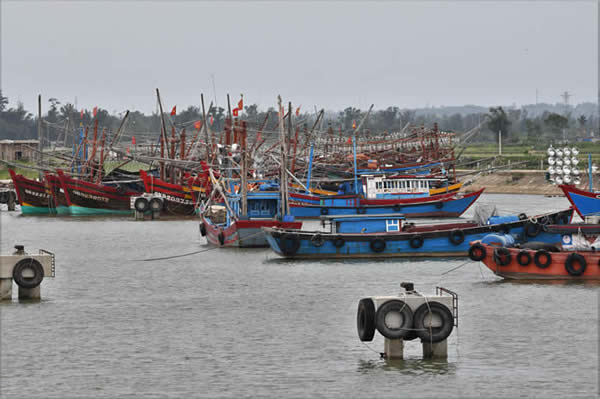
© 2018 Callyn Yorke
Our hotel in Hue made the arrangements for a private day-tour of the DMZ. That involved hiring a car, driver and guide; the latter individual would be picked up in Dong Ha City. His name was Tam.
Tam was a South Vietnamese village boy living in the DMZ along Route 9, near Camp Carroll when he first saw American soldiers. He recalled how they appeared "So young and innocent." He told us about one day when a young American soldier was searching his village for evidence of Viet Cong (VC) by probing underneath the raised hutches and looking into people's homes. At one point the soldier propped up his rifle on the side of a hut and crawled underneath to look around. Tam thought that was incredibly naiive, since some of his neighbors in the village had already been recruited by the VC. They were all watching the lone, rosy-cheeked American soldier, wondering how he would ever survive the war.
Tam literally survived the war by accident. Injuries he suffered to his foot from stepping on a grenade fuse, effectively eliminated him as a potential SVA recruit. He was sent by his family to Saigon during the war where he subsequently attended college, obtaining a degree in English. He told us many stories about those early days of the American War -- so many gripping, first-hand accounts about his family and friends disappearing or being tortured and killed, that we sometimes forgot to notice landmarks of the DMZ as we drove by them. After the war Tam became an English teacher, then retired as a part-time DMZ tour guide.
Tam showing the wartime injury to his foot, Vinh Moc 26 July 2018

© 2018 Callyn Yorke
Tam narrated the tour, guiding us to a number of significant sites in and around the DMZ. One of our stops was at the Da Krong Bridge over the Thach Han River at the junction of the Ho Chi Minh Trail. I got out of the car to stretch my legs, looking around the river for birds, which were generally scarce throughout the tour. About then a bus stopped on the roadside and several uniformed military personnel got out and began walking in our direction. Most of them were older men; a few women were with them. As they approached, they had some questions for me, e.g. Where are you from? Are you a veteran? One of them shouted out, "We are VC, REAL VC."
It was a friendly ambush. A few of the NVA vets, including two well-adorned with medals, were anxious to become aquainted with us. We posed for a series of group photos near the bridge. I told them I was a student during the American War and had never set foot in Vietnam prior to 2017. That remark landed like unexploded ordnance, momentarily silencing all of them. There was tension in the air, presumably due to an unscheduled encounter with a historically significant enemy, combined with a formidable language barrier.
Eventually, most of them were smiling, practicing their broken English and shaking hands with me. The surprise encounter with veteran NVA military officers was about as close as I would ever be to an authentic US-Vietnamese cease-fire agreement. Everyone seemed to appreciate the ironic juxtaposition of former enemies socializing on a tour of the DMZ.
Former Viet Cong officers and friends, Da Thao and I at the Thach Han river bridge

© 2018 Callyn Yorke
Although not originally on Tam's itinerary, he honored my request to visit the remote US Marine Base of Khe Sanh. Almost all of the original base infrastructure was removed when the base was abandoned in 1975. The Vietnamese government, however, thought the site significant enough to build a memorial museum decorated with a couple of bunker replicas, an ordnance collection, helicopters and tanks.
The atmosphere of the legendary combat base on this rainy morning was eerily quiet and somber. No other tourists were there and we had the place to ourselves for an hour or so, spending most of our time perusing some interesting museum exhibits. Intermittent showers discouraged us from doing much exploration of the surrounding area for birds. One Long-tailed Shrike was found in a tree next to the museum. A flock of munias flew by. That was about all of the birding available at Khe Sanh. I wondered if any of the US Marines during the war were birders. If so they were most certainly preoccupied by looking out for other kinds of airborne objects.
Tam showing on a relief map the location of Khe Sanh and some of the other sites we visited around the DMZ,
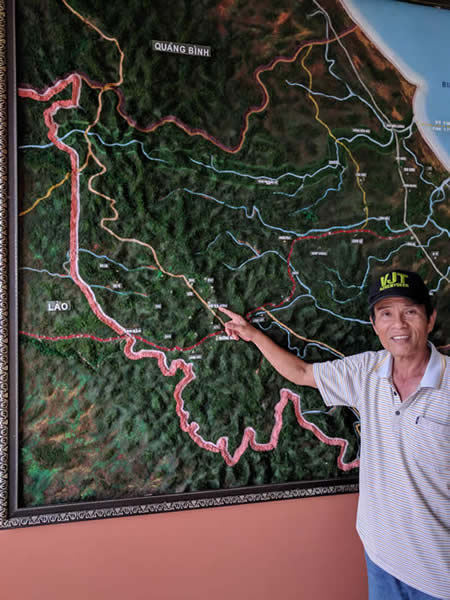
Khe Sanh Memorial Museum 26 July 2018 © 2018 Callyn Yorke
Khe Sanh Memorial 26 July 2018


© 2018 Da Thao Le Nguyen
From the photo exhibit in the Khe Sanh Memorial Museum 26 July 2018
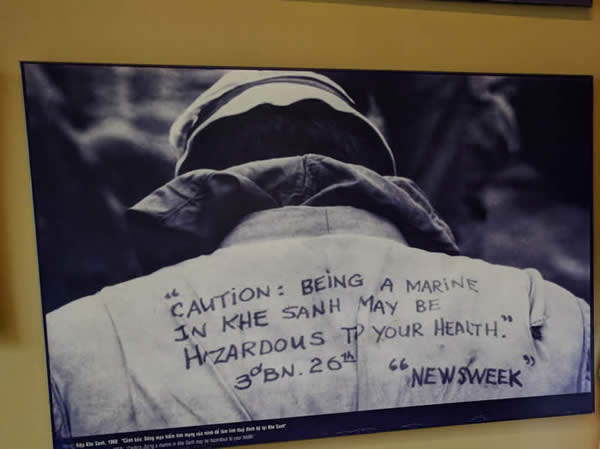
© 2018 Callyn Yorke
Our last stop on the DMZ tour was the coastal village of Vinh Moc. A short walk from the parking area and concession stands were stairways leading down to a three-level system of tunnels, of which only the top level was open to visitors. These are apparently the only accessible tunnels remaining in Vietnam. Unlike the extensive maze of tunnels at Cu Chi near Saigon, the Vinh Moc tunnels are spacious enough to allow visitors to walk through about 200 meters to a scenic shoreline opening, having almost enough headroom to stand up straight. Dimly lit corridors and cubbys featured ceramic models showing how hundreds of Vietnamese lived in these secret subterranean communities for years, while US warships shelled the coastline where their villages once stood. A few Volkswagen-sized craters can still be seen along the path leading to the tunnel entrance near the air shafts.
Inland entrance for one of the main tunnels at Vinh Moc 26 July 2018
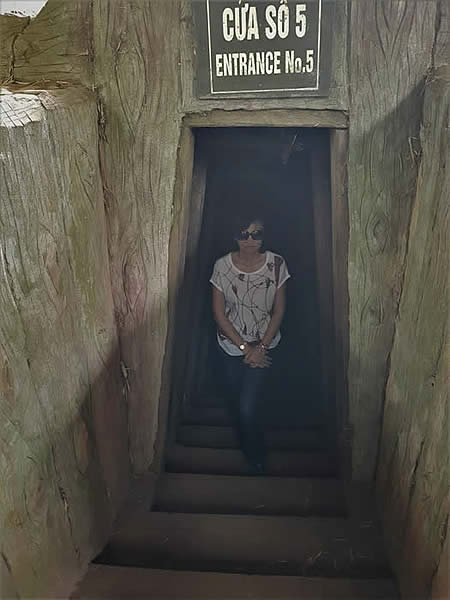
© 2018 Callyn Yorke
HO CHI MINH CITY (June 6-7; August 5; 13-16)
Birding the Saigon riverfront 7 June 2018
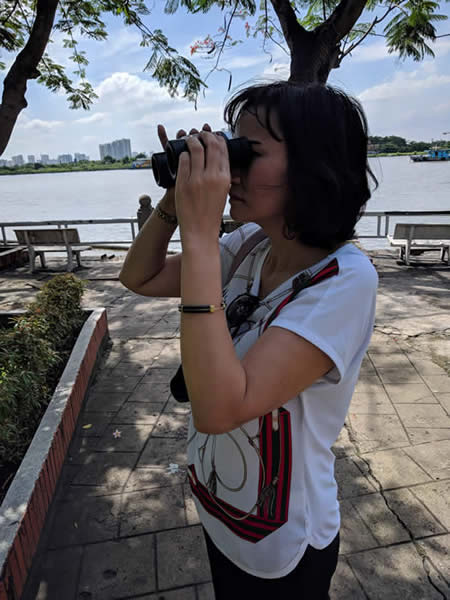
© 2018 Callyn Yorke
Ho Chi Minh City (Saigon), like Hanoi, has an abundance of hotel accomodations to suit all budgets. We selected a mid-range hotel in District 1, within walking distance to shops, restaurants and the Saigon River. HCMC was usually only a stop-over while in transit to other locations, e.g. Phu Quoc Island, DaLat, Los Angeles, CA.. We didn't have much time to explore the city.
Saigon - old and new - a city of contrasts 7 June 2018
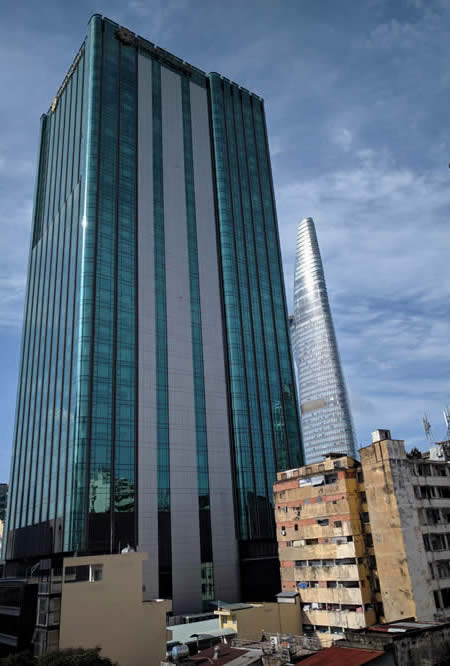
© 2018 Callyn Yorke
However, Saigon had a couple of very special attractions I was most interested to see, particularly the War Remnants Museum. Neither of us had been there before. Travel guide books described gruesome photos and other horrifying memorabilia from the American War. Yeah, sure, whatever. But neither of us were quite prepared for the actual experience of seeing all of it, close-up and personal. If in museums you tend to yawn in a fog of information overload, small print, eye fatigue and low blood glucose, this one is the antedote. Most visitors leave there visibly shell-shocked.
War Remnants Museum Saigon 7 June 2018
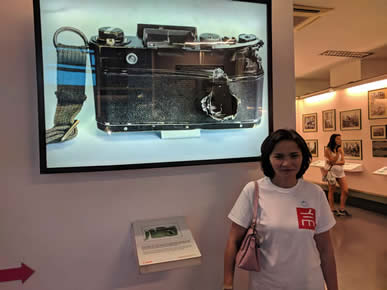
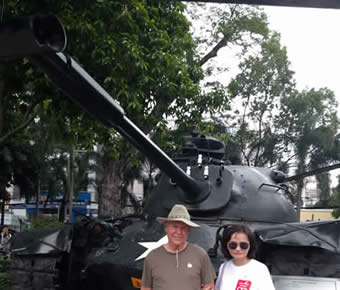
© 2018 Callyn Yorke
Another place of interest was the old Saigon Botanical-Zoological Gardens (BGZ). Just a short taxi ride from our hotel, the spacious gardens had hundreds of huge rainforest trees, some dating back to the garden's opening in 1865. The park contains water features, open enclosures, aviaries (ugh), a reptile house, habitat islands and, perhaps best of all, a riverside location. The shady pathways and cool breezes from the Saigon River tended to reduce the heavy summertime heat and humidity. Wild birds, squirrels, rats, lizards, butterflies and even a handful of escaped leaf-monkeys, occupy the gardens outside the rusty old cages. Most of the exotic captives were lethargic, except for an infuriated bull elephant in musk. Terrified onlookers gasped as the powerful beast tried to bash in a pair of heavy steel gates.
Saigon Botanical-Zoological Gardens 14 August 2018
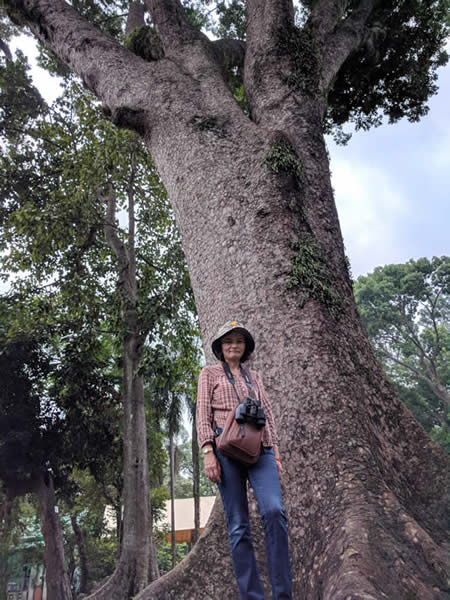
© 2018 Callyn Yorke
The Saigon BGZ was doubtless the best birding spot in the city. We made two separate, early morning visits and were not disappointed. Here are images I captured of some of the free-ranging birds and other wildlife found in the park...
Black-headed Ibis (Threskiornis melanocephalis) 15 Aug 2018 Streak-eared Bulbul (Pycnonotus blanfordi) 14 August 2018

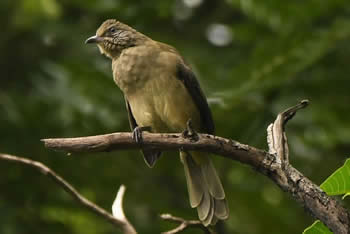
© 2018 Callyn Yorke
Lesser Adjutant (Leptoptilus javanicus) Saigon BGZ 14 August 2018
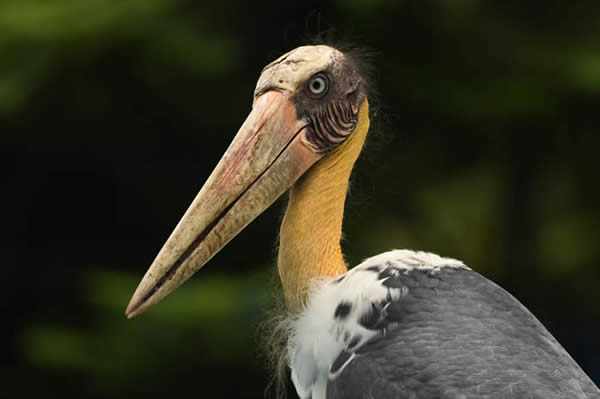
© 2018 Callyn Yorke
Purple Swamphen (Porphyrio porphyrio) Saigon BGZ 15 August 2018
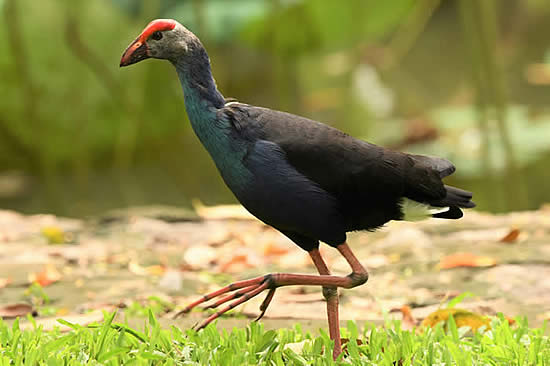
© 2018 Callyn Yorke
Oriental Darter (Anhinga melanogaster) Saigon Zoo-Botanical Gardens 15 August 2018
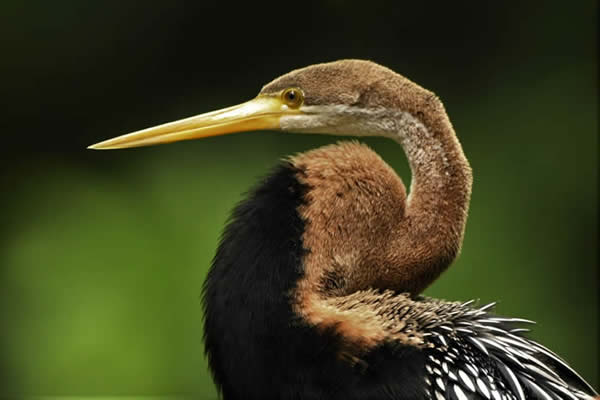
© 2018 Callyn Yorke
Calotes versicolor (male) Saigon Zoo-Botanical Gardens 15 August 2018
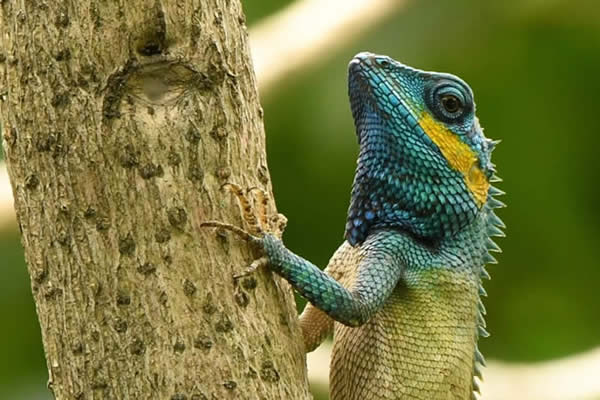
© 2018 Callyn Yorke
Tam Biet, Vietnam...
Ninh Binh Province, Northern Vietnam 9 July 2018
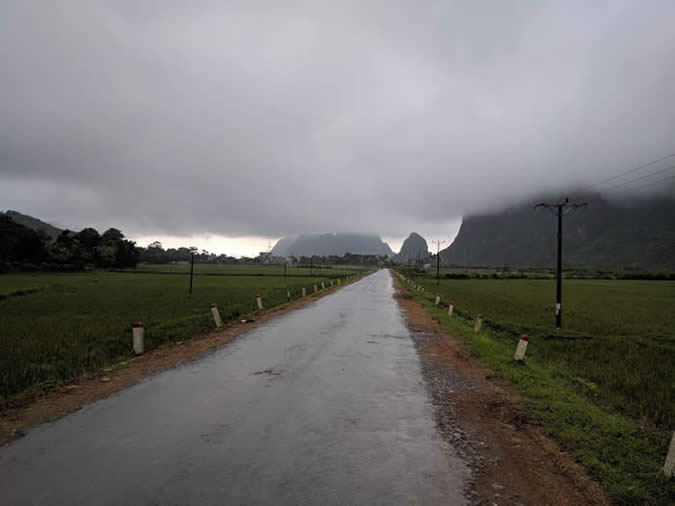
© 2018 Callyn Yorke
.